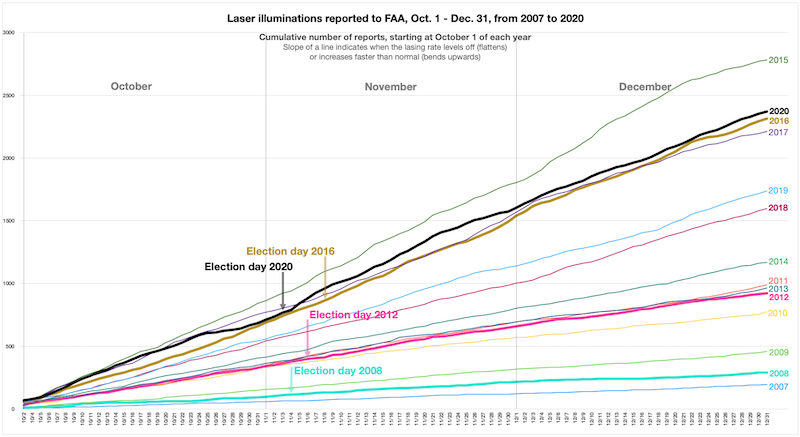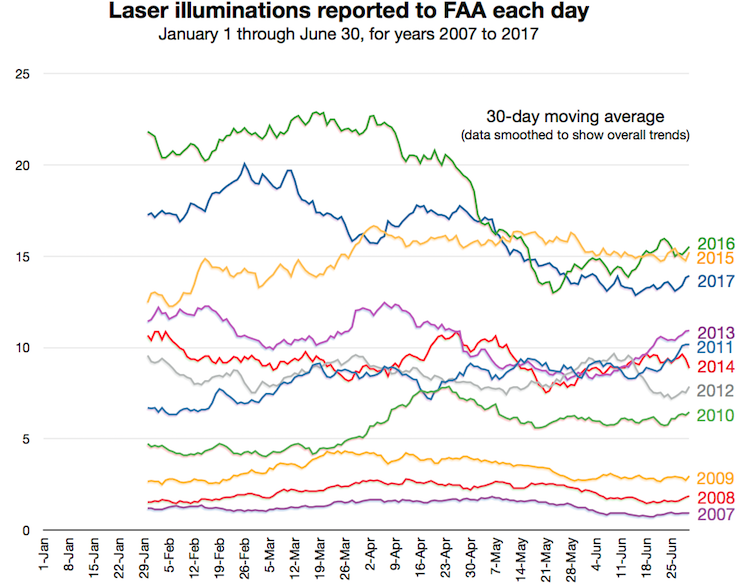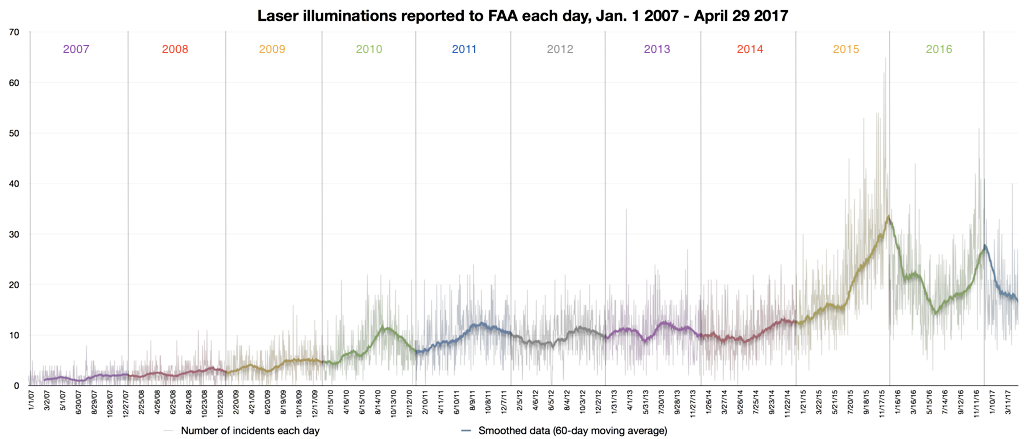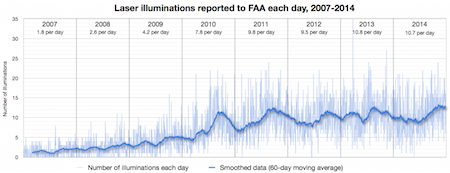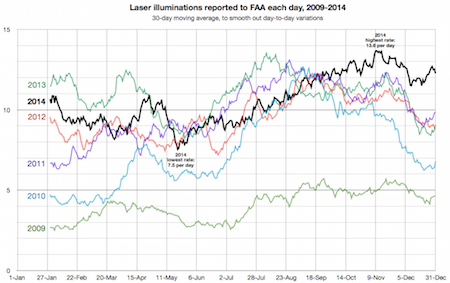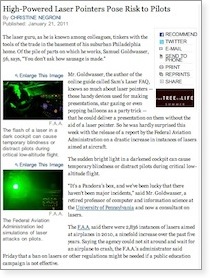Home
A comprehensive resource for safe and responsible laser use
US: GAO report says less than 1% of laser-aircraft incidents result in fines or prosecution
From July 2016 through September 2020, there were about 27,000 laser incidents reported by pilots to FAA.
Of these, 232 suspects were identified (0.86%). The "overwhelming majority… involved illumination of police and media aircraft", primarily helicopters that can hover over a scene. This hovering makes it much easier to identify perpetrators' locations, compared with fixed-wing aircraft that often cannot deviate from their route to chase after perpetrators.
FAA CIVIL ACTIONS
FAA took civil action against 99 of the 232 suspects:
• Assessed civil penalties against 70 of the 99 subjects. These civil penalties ranged from $50 to $27,338.29
• Proposed but had not assessed civil penalties against 17 of the 99 subjects.
• Ordered administrative actions (e.g. issuing warning notices to subjects) against three subjects
• Issued compliance actions (e.g. counseling) against eight subjects.
• Referred one case to the government of Canada for legal action because the subject was a Canadian resident.
This chart shows what happened to the remaining 133 suspects:
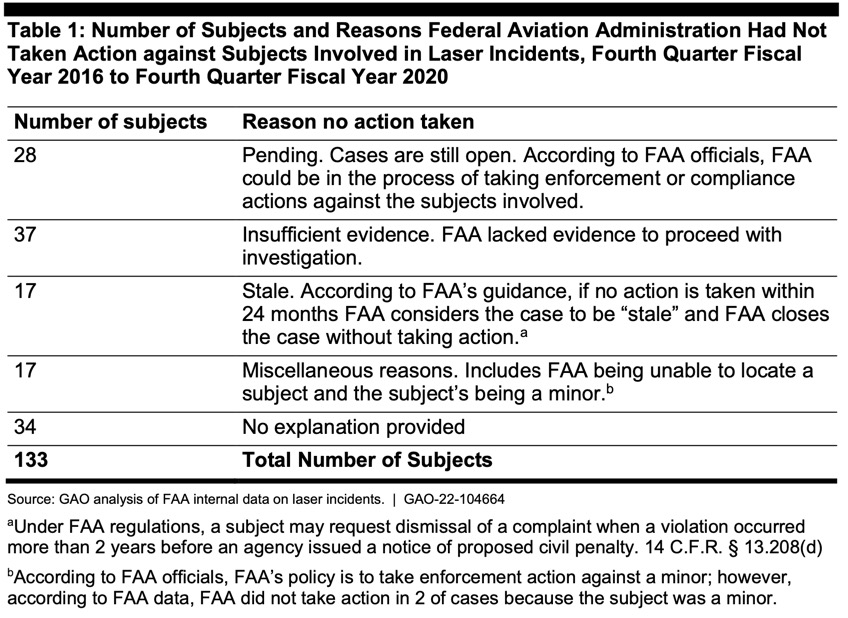
To summarize, out of 27,000 laser incidents there have been 70 persons fined so far (0.26%). There is the possibility of fining an additional 45 persons (17 proposed, 28 pending). If every one of these additional 45 persons was fined, that would make a total of 115 persons who would be fined (0.43%).
Thus, less than 1/2 of 1 percent of all laser incidents reported to FAA result in a fine or potential fine.
US ATTORNEYS' OFFICE CRIMINAL ACTIONS
In addition, there were criminal prosecutions. From the GAO report:
"According to our analysis, the FBI and other federal entities referred 86 laser incidents to USAOs for prosecution from July 2016 through September.32 Our analysis shows USAOs prosecuted 44 subjects, resulting in 40 convictions. In 23 of the 40 convictions, the subject received no term of imprisonment, while 15 subjects were sentenced to terms of imprisonment ranging from 3 months to 51 months."
"FBI officials told us federal prosecution may be more likely if a subject is suspected in a cluster of laser incidents, if a law enforcement aircraft was lased and a mission was interrupted, or if a subject had prior offenses, among other criteria."
Forty convictions out of 27,000 incidents is 0.15%. The 15 subjects imprisoned represent 0.06% of the incidents.
The report does not state if any of the criminal cases overlap with the FAA civil cases (e.g., a case is counted twice — once for FAA and once for criminal actions).
Data from the GAO's full 46-page report.
US: GAO report has three recommendations for FAA
The GAO began their study of the issue in November 2020. Their goal was to determine:
• "the extent to which [the U.S. Federal Aviation Administration] FAA and other federal agencies take enforcement action against those who point lasers at aircraft and challenges with investigations and reporting;"
• "public outreach efforts FAA and other federal agencies have taken to deter laser incidents, and what actions, if any, would strengthen these efforts; and"
• "options that stakeholders have identified to mitigate the effects of laser incidents, and the potential benefits and challenges to implementation."
FINDINGS
The following is from the "What GAO Found" summary of their findings:
"Aiming a laser at an aircraft can distract or disorient pilots and is a federal crime. The Federal Aviation Administration (FAA) investigates laser incidents, pursues civil penalties, and assists the Federal Bureau of Investigation (FBI) and U.S. Attorneys with investigations. Given the nature of laser incidents, FAA and federal law enforcement face difficulties identifying those involved. However, they have taken some enforcement actions, resulting in penalties ranging from $50 to $27,388 and sentences of up to 51 months, according to GAO analysis."
"To support incident investigations, FAA asks that pilots complete an incident questionnaire upon landing. However, FAA received responses for about 12 percent of the 8,221 laser incidents that occurred over a recent one-year period from 2020 to 2021. Reasons identified by FAA and others for the low response rate include the length of the questionnaire and its voluntary nature. Further, FAA does not consistently share collected information with law enforcement."
"In 2016, Congress required FAA to report quarterly on laser incidents, including data on civil and criminal actions. However, GAO found FAA’s reports to be incomplete. For example, GAO’s analysis shows 44 prosecutions from July 2016 through September 2020, when FAA reported only four. FAA officials said they do not routinely request data on the status of actions from other agencies and face challenges, such as access to this data. By not routinely seeking updates from agencies, FAA does not provide Congress with a complete picture of laser incident investigations and enforcement actions as required."
"FAA, FBI, and the Food and Drug Administration, which has regulatory authority over lasers, each conduct outreach to educate the public about laser incidents. These agencies were involved in an interagency group to address laser safety concerns until 2015 when the group dissolved. Since then, laser incidents have increased and identifying subjects remains difficult. FAA is well positioned to lead an interagency effort to explore re-establishing this group, given FAA’s responsibility for the safety of the national airspace."
RECOMMENDATIONS
The 46-page report recommended three actions to be taken by FAA:
1: "The FAA Administrator should determine what information from pilots and crewmembers would be most useful for investigating laser incidents, and how best to collect the information and to share it with law enforcement."
2: "The FAA Administrator should improve its quarterly reports to Congress on laser incidents by routinely seeking information from other agencies on related federal investigation and enforcement actions and disclosing, in those reports, any limitations with the data."
3: "The FAA Administrator should work with FBI and FDA to explore re-establishing an interagency working group on outreach to educate the public on the hazards of lasers and the illegality of aiming lasers at aircraft."
From the GAO webpage about the report. It includes a link to the full 46-page report.
COMMENTARY FROM LASERPOINTERSAFETY.COM
While the three recommendations are useful, we are disappointed that the GAO report did not make a primary recommendation that FAA should require pilot training on how to handle laser illuminations. In our view, this is the single most important safety step that FAA could take.
The report does discuss this, beginning on page 30 with this paragraph:
"Most stakeholders told us that training pilots on how to respond to laser incidents is an important mitigation strategy. For example, representatives from an organization representing law enforcement pilots told us that training pilots in responding to laser incidents is important because there will always be laser incidents. These representatives said that even with effective public outreach and enforcement activities, there would be people intentionally trying to harm aircraft and that in these situations, it is important for pilots to know how to react. Additionally, representatives from a group representing pilots told us they recommend airlines develop and incorporate a laser strike training module at a minimum of every 2 years." (emphasis added)
However, the GAO report simply lists some pilot training efforts. It does not say that FAA should mandate this.
LaserPointerSafety.com has also recommended that pilots be exposed to safe, simulated laser light during simulator training. This gives a flavor of what a bright light disruption can be and helps "inoculate" pilots so they know what to do, just as they train for other aviation emergencies.
US: 9,723 illuminations reported to FAA during 2021
This means pilots saw lasers on average 26.6 times each day in 2021.
The chart above, and other detailed statistics, are on the Laser/aircraft illuminations statistics page. This includes data such as the following:
- The total number of U.S. laser/aircraft incidents since reporting to the FAA was mandated in 2004, is 71,435 as of Dec. 31, 2021.
- The total number of worldwide laser/aircraft incidents reported to authorities since 2004 is 102,104. Only eight countries are included in this cumulative total, and many of these do not have data for some years in the 2004-2021 time period, so the actual number of incidents is higher.
- Green laser light remains the most-reported. In 2021, 86.1% of incidents involved green light; blue was second with 8.8%. The number of blue lasers reported has, in general, increased over the past few years. For example, in 2016 only 2.9% of incidents involved blue laser light.
- In 2021, 0.5% of FAA-reported laser/aircraft incidents indicated that crew members suffered eye effects or temporary injuries. This rate has decreased since 2011, when 1.4% of incidents incurred eye effects or temporary injuries. The most-reported effects were flashblindness and/or afterimage; pain, burning or irritation; blurriness; and unspecified eye injuries.
NZ: Number of laser strikes on aircraft decreases, but may be due to flights decreasing
The March 2021 New Zealand data has been updated on the Laser/aircraft illumination statistics page. Scroll down to the "New Zealand" section. Also updated is the section comparing five countries including New Zealand.
The information was in a March 15 2021 email from CAA-NZ to LaserPointerSafety.com. The email noted that "Unfortunately our 2020 numbers were low primarily because our aircraft movements dropped so much due to Covid-19."
To look into this further, LaserPointerSafety.com estimated that in 2020 there were 273,000 airport movements (defined as a takeoff, landing or missed approach handled by Airways New Zealand). This compares with 1,023,000 movements in 2019 and a similar number in 2018.
Using this metric, in 2020 there were 256 laser illuminations per 1 million movements. This would be actually be a significant increase from the 2019 figure of 232 laser illuminations per 1 million movements.
Such a comparison may not be fully valid, however. The number of movements probably does not include flights by police and rescue aircraft. Because these are disproportionately targeted by laser perpetrators, a complete analysis would need to include such flights. It is not known if data are available.
Data from a March 15 2021 email from CAA-NZ. Thanks to Jenny Knowlsey for this data. Additional data on New Zealand aircraft movements is listed on the Laser/aircraft illumination statistics page under the "illuminations per 1 million flights" chart. Note that although "airport movements" are discussed above, on the statistics page this has been converted to "flights" by dividing the movements in half. This was done because "flights" is more understandable to the general public than "airport movements."
US: Why did lasers aimed at aircraft increase after the 2020 election?
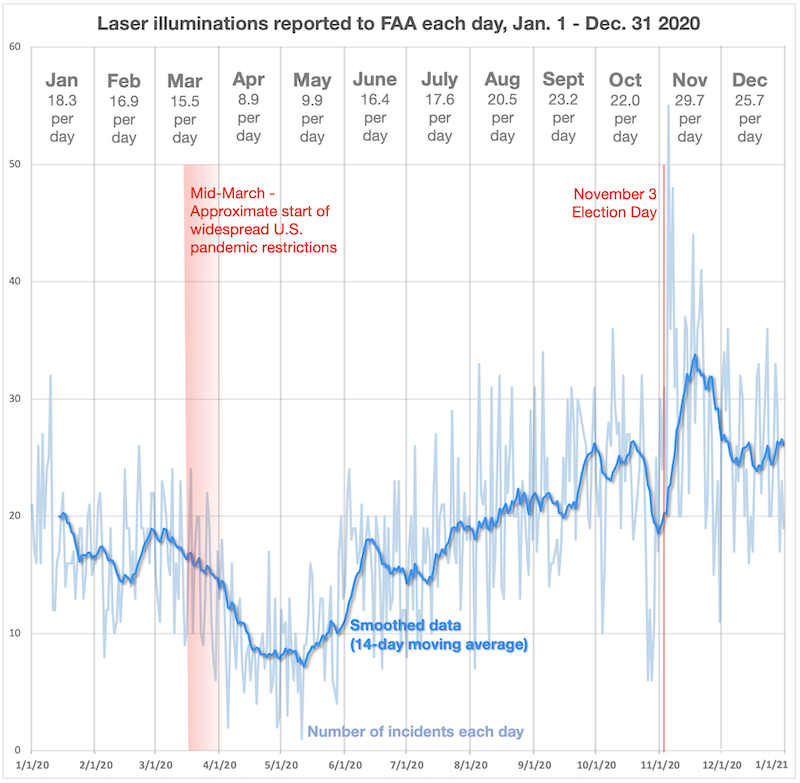
In fact, of the 10 highest days (most incidents) in 2020, all but one occurred in the Nov. 5-21 period. There were 55 incidents on Nov. 5, 48 on Nov. 6, 44 on Nov. 17, and 41 on Nov. 21. These occurred more than twice as often, compared with the 2020 average of 18.7 incidents per day.
Is this a statistical anomaly or did the disputed election results somehow lead to an increase in laser incidents?
COMMENTARY AND ANALYSIS BY LASERPOINTERSAFETY.COM
The chart below indicates that the three previous U.S. presidential elections did not have an effect on lasing incident rates.
It shows that in 2008, 2012, and 2016 the number of laser incidents each day between October 1 and Dec. 31 rose smoothly and steadily. In contrast, the lasing rate in 2020 (black line) slowed substantially around October 26, and rose significantly just after Election Day on November 3.
However, these two effects appear to counter each other. It may be that some other factor, such as how FAA records or processes laser incident reports, slowed in late October and sped back up in November.
In summary, while it is tempting to say that agitation over the 2020 election results led to an increase in persons aiming lasers at aircraft, this was not seen in previous election years and may be a statistical anomaly.
US: 6,852 laser illuminations reported to FAA in 2020
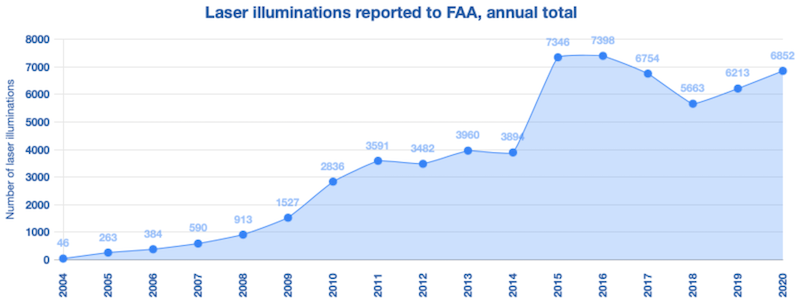
This means pilots saw lasers on average 18.7 times each day in 2020. However, the lasing rate was not evenly distributed. It reached a monthly low of about 9 illuminations per day in April 2020 — just as nationwide pandemic restrictions started. The highest rate was in November 2020, with almost 30 illuminations per day.

The peak number of illuminations, 55 on Nov. 5, occurred two days after the contentious 2020 election, when a presidential winner had not yet been declared. Of the 10 highest days (most incidents) in 2020, all but one occurred in the Nov. 5-21 period. A separate story at LaserPointerSafety.com discusses whether this is a coincidence or if there is some correlation with the election.
The charts above, and other detailed statistics, are on the Laser/aircraft illuminations statistics page. This includes data such as the following:
- The total number of U.S. laser/aircraft incidents since reporting to the FAA was mandated in 2004, is 61,712 as of Dec. 31, 2020.
- The total number of worldwide laser/aircraft incidents since 2004 is over 90,000. Only eight countries are included in this cumulative total, and many of these do not have data for some years in the 2004-2020 time period.
- Green laser light remains the most-reported. In 2020, 85.4% of incidents involved green light; blue was second with 9.2%. The number of blue lasers reported has steadily increased over the past few years. For example, in 2016 only 2.9% of incidents involved blue laser light.
- In 2020, only 0.3% of FAA-reported laser/aircraft incidents indicated that crew members suffered eye effects or temporary injuries. This rate has decreased since 2011, when 1.4% of incidents incurred eye effects or temporary injuries. The most-reported effects were flashblindness and/or afterimage; pain, burning or irritation; and blurriness.
UK: Petition to ban all laser pens looking for 10,000+ signatures
Claire Tucker undertook the effort out of fear for her husband Dan's safety. As of early September 2020, a Wiltshire air ambulance had been illuminated four times by laser light. Her husband was involved in at least one of those, on September 7, in which he saw 'red spots for a while after the laser caught him."
That night, Claire Tucker made an emotional appeal on Facebook, which was also put online by BBC News. In it she said, in part:
"Last night, Dan was in the helicopter, and all of a sudden, they were just about to come in to land. So all of a sudden, the laser light came in and caught Dan's goggles. So when it hits the goggles, it magnifies it. Number one: It could blind him. It could mean that he never gets to see his children again. If they were unlucky enough to hit the pilot's goggles, it could: A, blind the pilot, but B, disorientate the pilot, which will mean the helicopter hits the ground. Okay? So you're going to cause a helicopter crash… If you know anybody that has one of these lasers, please, take it off them, throw them out. Somebody knows somebody who's got these bloody lasers. Alright? It needs to stop. I do not want a knock on the door in the middle of the night by the police because the helicopter has come down."

Tucker during her Facebook appeal
She researched pointers online and found a laser pen on eBay with a claimed 50 mile range for £12 (USD $15.50). Her goal is to get laser pens banned for sale and importation.
US: 2019 laser incidents up almost 10% compared to 2018
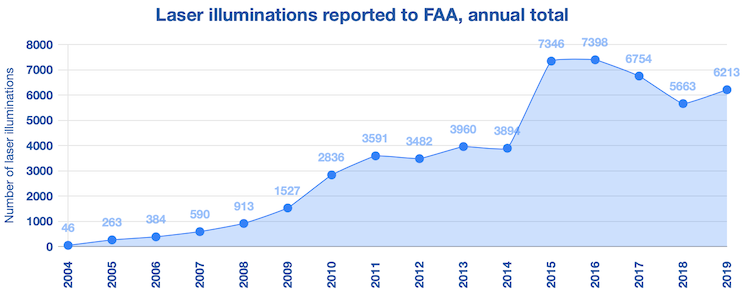
During 2019 there were 17 laser incidents reported each night in the U.S., on average.
This brings the 15-year total to 54,860 incidents since 2004 when FAA first started requiring pilots to report laser sightings or illuminations.
The majority of reports continue to involve green lasers (87.2% of 2019 reports). However, reports of blue lasers have risen steadily, from 2.9% in 2016 to 8.2% in 2019.
Holiday lights do not seem to be a significant problem. In 2019 there were only 11 reports (out of 6,213) involving Christmas or holiday laser light projections.
The number of incidents with reported eye effects or claimed injuries was 31 in 2019, a significant increase over the 23 reported in 2018. There were no serious or permanent injuries. The most-reported effect was being flashblinded and/or seeing spots. Six pilots had pain, burning or irritation in their eye. Only three pilots sought or considered seeking medical attention for their eye effects — the lowest number in the seven years analyzed by LaserPointerSafety.com (2011, 2012, and 2015-2019).
FOR MORE INFORMATION: Additional charts showing U.S. and other country laser illuminations, are on the Laser/aircraft illumination statistics page.
US: Cautions about outdoor holiday laser displays
In Norfolk, Virginia, a pilot for Sentara Norfolk General Hospital told a news crew that laser light displays can be hazardous: "Every little distraction or interruption can mess with your normal routine and cause you to make mistakes and miss something that might be important." He said "Those lasers carry a long way, particularly in this cold, clear winter weather that we're experiencing right now."
The news report noted that ironically, the pilot has a laser display but he hasn't yet plugged it in on the outside of his house. He said homeowners can use them but should not aim the lasers into the sky.
From 13 News Now
Columbus, Ohio police said they are concerned with consumer drones and holiday laser lights. The laser displays "could cause the same effect as a 'laser strike' as we call it and that could blink the crew and it can become a disaster," said a Columbus Police sergeant. He also asked users to double-check where they are being aimed.
From 10 TV WBNS
South Africa: 70+ laser incidents reported in 2018
In one case at at O.R. Tambo, Africa's busiest airport, "a commercial airliner on final approach to touchdown had to perform a go-around after a laser was directed at the eyes of the flight crew."
Two men in Bloemfontein were recently arrested for aiming lasers at helicopters. According to the story, "[a]s far as can be ascertained only one arrest has previously been made for shining a laser," which happened during the 2010 FIFA Soccer World Cup in Durban.
The New Age Online reported "Both the Civil Aviation Authority (CAA) and Airline Pilots Association of SA (ALPA) have spoken out strongly against the practice, which carries a maximum sentence of 30 years in jail…. ALPA general manager Sonia Ferreira said members were increasingly reporting incidents of 'sudden and intense bursts of light, deliberately shone at aircraft in and around airports'."
From the New Age. The article first appeared online May 14 2019.
US: FAA data shows lower numbers for 2015 and other years
The original, higher figure came from the December 31 2015 FAA Laser Report. This spreadsheet of laser incidents had 7,703 rows with each row listing one laser illumination report.
In January 2016, researcher Dr. Todd Curtis cleaned up the list and found 7,676 valid reports. (The clean-up criteria is not known.)
The FAA's new, lower number of 7,346 reports was first noticed by LaserPointerSafety.com in an April 10 2019 fact sheet released by FAA. The agency has a separate page with Microsoft Excel spreadsheets listing reported laser incidents for 2010 through 2018. The spreadsheet now online for 2015 has only 7,346 reports — not the 7,703 reports of the original December 31 2015 FAA spreadsheet.
LaserPointerSafety.com has analyzed some of the dropped reports. A few may be duplicates, but many appear to be valid reports dropped for an unknown reason.
LaserPointerSafety.com believes that the original 7,703 figure is closer to the actual number of laser illumination reports submitted by pilots in 2015. However, for consistency, as of May 5 2019, LaserPointerSafety.com is using the new April 2019 FAA numbers on various pages such as the Laser/aircraft illumination statistics page.
Note that there may be some website pages and some articles, scientific papers, etc. outside of the website which reference the original, pre-April 2019 numbers.
Changed numbers also for 2007, 2008, 2016 and 2017
The number of laser incidents reported in other years has also changed:
- 2007 was originally listed as having 639 reports; in April 2019 FAA said there were 590 reports.
- 2008 was originally listed as having 949 reports; in April 2019 FAA said there were 913 reports.
- 2016 was originally listed as having 7,442 reports; in April 2019 FAA said there were 7,398 reports.
- 2017 was originally listed as having 6,753 reports; in April 2019 FAA said there were 6,754 reports.
US: FAA credits "heightened public awareness" for lowering laser incident numbers in 2017 and 2018
Incidents reported to FAA have declined from 7,398 reports in 2016, to 6,754 reports in 2017, and 5,663 reports in 2018, the last full year for which statistics are available.
According to FAA, "the agency and law enforcement agencies are working hard to increase public awareness of the dangers posed by lasers."
The news item linked to a page entitled "Laser Incidents and Legal Interpretation of the Law", a new video published April 10 2019 on YouTube, entitled "Laser Strikes on Aircraft Pilots", and an April 10 2019 Fact Sheet on lasers.
One paragraph of the fact sheet says that "The FAA’s guidance for agency investigators and attorneys stresses that laser violations should not be addressed through warning notices or counseling. The agency seeks moderately high civil penalties for inadvertent violations, but maximum penalties for deliberate violations. Violators who are pilots or mechanics face revocation of their FAA certificate, as well as civil penalties."
From FAA news item "Outreach Helps Bring Laser Strike Numbers Down"
COMMENTARY FROM LASERPOINTERSAFETY.COM:
We are not aware of any recent (2015-2018) campaign by FAA to increase public awareness.
In 2014, there was a publicity campaign by the Federal Bureau of Investigation (FBI) in 12 U.S. cities between February 11 and April 11 2014, which offered a $10,000 reward for information about anyone pointing a laser at an aircraft. This was expanded nationwide between June 3 and September 1 2014. During 2014 there was a 12.8% decline in laser incidents compared to 2013. It is not known how much the FBI publicity campaign contributed to the decline.
In our view, there may be other reasons for the decline. For example, pilots may be tiring of reporting laser illuminations with no apparent follow-up or effect. This would lead to a decline in reported incidents.
We are not aware of any studies done to determine the reasons for declines in reported laser incidents.
To summarize, it seems incorrect to attribute the lower number of laser incidents to "heightened public awareness." In fact, there is some anecdotal evidence that publicity actually leads to copycat laser incidents.
New Zealand: Pilots, legislator want total ban on handheld lasers over 1 mW
The bill would double penalties for violations from the current 3 months imprisonment or $2000 fine, to 6 months or $4000. And it amends the Crimes Act 1961 to make explicit that interference with a transport facility includes using a high-power laser pointer to reduce the ability of aircraft crew to perform their duties.
The High-power Laser Pointer Offences and Penalties Bill was introduced September 6 2018 by Clutha-Southland MP Hamish Walker.
The president of the New Zealand Airline Pilots Association said "We are asking for a prohibition primarily because the risk outweighs markedly, any utility they are having in society. We don't believe they need to be in the country there is plenty of other alternatives as we are calling for a complete prohibition."
In Wellington in August 2018, a $20 million control tower was opened. On its first day of operation, several staffers reported a laser being aimed in their eyes. Some had to lie down after experiencing nausea.
A police database of incidents found 311 reports in 2018 using the keyword "laser."
From the High-power Laser Pointer Offences and Penalties Bill and NewstalkNB.
US: FAA warns against aiming holiday lasers into the sky
With the holiday season upon us, the Federal Aviation Administration (FAA) wants to make sure your laser-light displays are aimed at your house and not into the sky.
Each year we receive reports from pilots who are distracted or temporarily blinded by residential laser-light displays. You might not realize this, but a well-meaning attempt to spread holiday cheer has the potential to create a serious safety risk to pilots and their passengers flying overhead.
So please make sure all laser lights are directed at your house and not into the sky. The extremely concentrated beams of laser lights reach much farther than you might realize.
If we become aware that your laser-light display affects pilots, we’ll ask you to adjust them or turn them off. If your laser-light display continues to affect pilots, despite our warnings, you could face a civil penalty.
Laser strikes against aircraft continue to increase each year. Last year we received 6,754 reports of laser strikes against aircraft, a 250 percent increase since we started tracking laser strikes in 2010.
Intentionally aiming a laser at an aircraft is a serious safety risk and violates federal law. Many high-powered lasers can completely incapacitate pilots who are trying to fly safely to their destinations and may be carrying hundreds of passengers.
We work with federal, state, and local law enforcement agencies to pursue civil and criminal penalties against individuals who purposely aim a laser at an aircraft. We may impose civil penalties of up to $11,000 per violation. Civil penalties of up to $30,800 have been imposed by the FAA against individuals for multiple laser incidents.
Germany: Laser/aircraft incidents decline 12.4% compared to last year
This decrease is despite a doubling of incidents at Frankfurt International Airport. In the first half of 2018 there were 22 laser illuminations versus only 11 during the same period in 2017.
Declines were reported at Munich, Hamburg and Stuttgart airports.
A spokesperson for the German pilots' union Vereinigung Cockpit seemed to indicate that increasing prosecutions were a cause of the drop from 2017 to 2018: "A few years ago, the laser attack was a hip prank for some young people. The perpetrators must now be aware that they are consistently prosecuted."
From DW.com reporting on a story from public broadcast service ARD. Thanks to Greg Makhov for bringing this to our attention.
UK: Average of 50 laser illuminations of military aircraft per year in UK
It is not clear if these military incidents are included in the Civil Aviation Authority (CAA) statistics about laser illuminations of aircraft.
The Ministry of Defence figures, made public June 11 2018, were rounded to the nearest 10. The list below shows the reported military-related laser incidents in the UK, along with the CAA numbers for the UK and for overseas UK operators
2013 - 40 military, 1396 CAA UK home, 329 CAA UK overseas operators
2014 - 70 military, 1447 CAA UK home, 317 CAA UK overseas operators
2015 - 70 military, 1440 CAA UK home, 355 CAA UK overseas operators
2016 - 30 military, 1258 CAA UK home, 274 CAA UK overseas operators
2017 - 40 military, 989 CAA UK home, 243 CAA UK overseas operators
The information was released in response to a written parliamentary question submitted by former defence minister Kevan Jones, who said “New laws to deter those stupid enough to carry out these attacks might not be enough, and the Government should give police operating around air bases the resources needed to catch offenders.”
From the Mirror. We have additional statistics and stories about the UK, plus a page with statistics about the UK and other countries.
New Zealand: Pilots want high-powered laser pointers banned
The April 18 2018 call for prohibition follows two recent reported incidents:
- On April 12 an Air New Zealand plane was hit by a laser strike near Kerikeri Airport at about 6:10 am, just after taking off
- On April 15 there was a laser illumination of a Mount Cook Airline plane flying over the Canterbury town of Rolleston
There were approximately 169 laser/aircraft incidents in 2017, according to the Civil Aviation Authority.
NZALPA news from the New Zealand Herald, details on Kerikeri incident from Stuff Travel, details on Rolleston incident from The Press. Click the “read more” link for additional details in the NZALPA April 18 2018 press release.
Click to read more...
UK: NPAS says only 1.4% of laser perpetrators were prosecuted
James Cunningham told Police Oracle in a March 21 2018 article that there were a number of reasons for the low prosecution rate, including being not being able to follow the laser perpetrator due to being focused on another job (e.g., completing the original mission).
Also, when lasers are pointed from a tower block area, the helicopter crew may not be able to locate the source.
In 2017 there were 67 incidents [not clear if this is NPAS only], compared with 70 in 2016 and 103 in 2015. Cunningham said the reduction is because NPAS is trying to locate and pursue laser perpetrators, and report the incidents as crime. He said the Laser Misuse (Vehicles) Bill being considered in Parliament is a “step in the right” direction that could lead to more prosecutions.
In December 2017, NPAS purchased laser-reducing glasses which can enable pilots to continue even when illuminated by laser light.
From Police Oracle
US: UPDATED - 6,753 laser/aircraft incidents reported to FAA in 2017; 9% lower than 2016
During 2017, there were 6,753 laser illumination incidents reported to the U.S. Federal Aviation Administration. This compares with 7,442 reports in 2016, and 7,703 reports in 2015. This is a 9% drop compared with 2016, and a 12% drop compared with 2015.
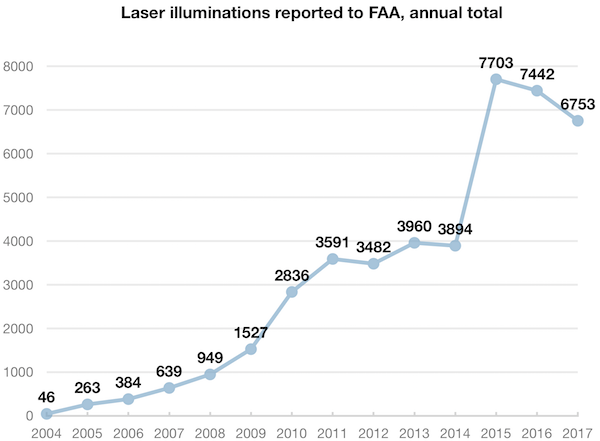
Here is the same data, plotted to show the average number of illuminations per day, during each year:
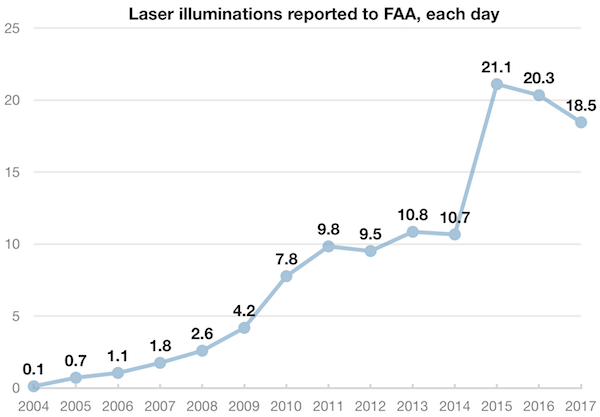
For additional charts and statistics, click the “read more” link.
New Zealand: Laser pointer/aircraft incidents increase about 11% in 2017
If this rate of 14 incidents per month holds for December, the 2017 total will be around 169. This would be an 11% increase over 2016.
The information comes from the Civil Aviation Authority which noted that most incidents occurred in metropolitan centers. The CAA deputy director of air transport and air worthiness, Mark Hughes, warned "People are not aware of the significance of it. It's sort of a lark, or a fun thing to do, not recognizing that actually they're causing a real safety issue and creating a danger for pilots and passengers…. It could cause an accident if the pilot is visually impaired at a critical phase of the flight.”
From Radio New Zealand
US: Utah National Guard reluctant to report laser cases to FBI, apparently after suspect's suicide
In an interview, Chief Warrant Officer Robert Williams discusses the hazards of laser interference with pilots. He recounts an episode in mid-July 2017 where he and a co-pilot were lased. They identified the source of the laser beam. Ground officers found that the perpetrator was a teenager. Williams said “We specifically requested that the cops not get the FBI involved. I don’t want any kids going to jail or getting felony charges on their record.”
He added, “When the cop showed up at the door and explained to the dad what was going on, the dad broke the kid’s laser there on the spot.”
The reluctance to report appears to stem from a 2009 lasing incident which was reported to the FBI. A 30-year-old man, Joshua Don Park, “on a whim” decided to aim a cat laser pointer at a Utah National Guard helicopter. Park told arresting officers that he was unaware the laser’s light could interfere with pilots’ operations. The Journal story says Park “faced up to five years in prison. [Another source says he faced up to 20 years.] Tragically, he committed suicide shortly before he could be sentenced.”
The story continues, “Since that sobering incident, no Utah National Guard pilots have reported lasing incidents to the FBI—but not for lack of occurrences. ‘My unit alone has had two incidents in the past three months,’ said Williams.”
From the South Valley Journal. More details about the original February 2009 lasing and September 2009 suicide are here.
US: UPDATED - 2017 laser incidents on pace to be lower than 2016
As of June 30 2017, there were 2,933 laser illuminations of aircraft reported to the U.S. Federal Aviation Administration. This is 15% fewer than the 3,441 illuminations reported as of June 30 last year (2016).
The chart below shows cumulative laser illuminations for the period Jan. 1 - June 30, for each of the past 10 years. The blue 2017 line shows that thus far there have been fewer incidents in 2017 than in 2016, but more than in 2015.
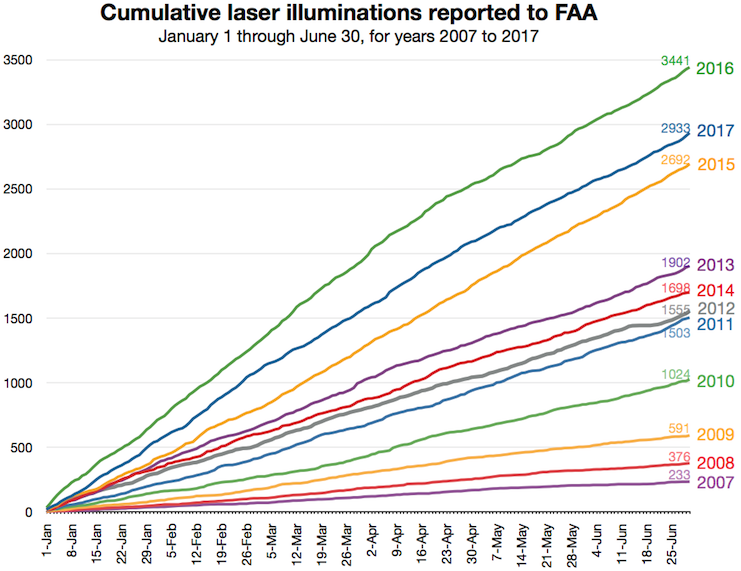
How to read this chart: Each year starts with 0 illumination reports. Each colored line then plots the cumulative (year-to-date) illumination reports for that year since January 1. For example, looking at the 2016 top green line, there were about 1000 reports between Jan. 1 and Feb. 12 (where the green 2016 line crosses the 1000 horizontal line). In contrast, in 2013 (purple line) there were roughly 500 reports between Jan. 1 and Feb. 12 (where the purple 2013 line crosses the 500 horizontal line).
Based on historical data, LaserPointerSafety.com projects that there will be around 7,200 laser illuminations reported to the FAA in 2017. This would be about 4% lower than the 7,442 reports in 2016, and about 7% lower than the 7,703 reports in 2015.
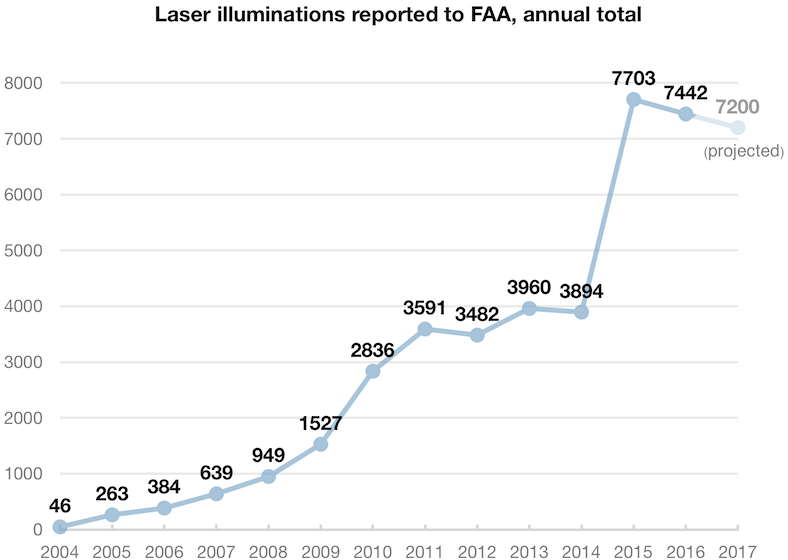
The next chart shows the number of laser illuminations per day. Each line is a different year. The lines have been smoothed by averaging the previous 30 days (a 30-day moving average). For this reason, the lines do not start until January 30.
This shows trends within a year. For example, in both 2016 and 2017 the number of reports dropped significantly in early May, while in 2015 the number of reports was more constant during that period.
The chart below shows the number of laser illuminations for every single day between Jan. 1 2007 and April 29 2017. The light spiky line shows each day’s illumination reports. This number can vary widely from one day to the next. The dark line is a 60-day moving average. This helps smooth out the data, in order to show longer-term trends.
From these charts, it can be seen that illumination reports grew slowly, or even declined, in the first few months of 2015, 2016 and 2017. However, in the final months of 2015 and 2016, the number of illumination reports picked up significantly. The estimate above (that there will probably be around 7,200 reports in 2017) takes this effect into account.
Statistical note: The careful reader will see that the blue 2017 line in the first chart falls between the 2016 and 2015 lines. Yet LaserPointerSafety.com predicts 2017 as a whole (Jan-Dec) will be lower than both 2016 and 2015. This is because we used all ten years, 2007-2016, to estimate the year-end total as a proportion of the first six months. Both a simple average of these ten years, and a weighted average — where more recent years have a larger effect — indicate that the 2017 total will be in the ballpark of 7,200 illuminations. In other words, 2015 was an atypical year where illuminations in the last eight months of the year grew much faster than any other year.
Taiwan: CAA considering restrictions after 8 laser incidents in first six months of 2017
In previous years the Air Navigation and Weather Service had 4-5 reports per year of laser interference. As of late June 2017, there had been 8 reports.
The most recent incident happened June 21 2017, when China Airlines flight 163 was landing at Taoyuan International Airport. Laser beams were coming from near to the runway. The pilot “requested that the interference be moved, after which the flight landed safely.”
From the Taipei Times
UK: 1,258 laser/aircraft incidents in 2016, a 12.6% drop from 2015
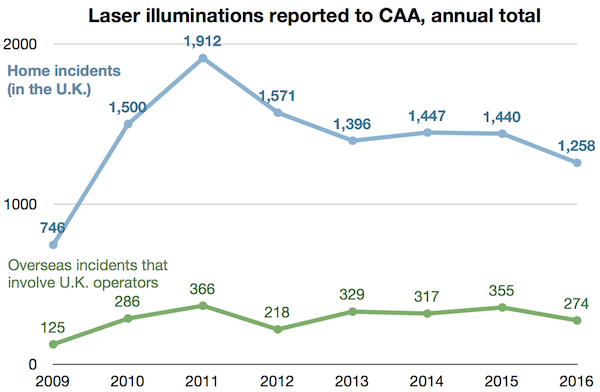
Note: Previous stories and charts elsewhere on LaserPointerSafety.com may have slightly different figures for some years. This is due to CAA updating numbers after a “SDD Coding Backlog”. The numbers above are all as reported in February 2017 by CAA.
The 1,258 home incidents in 2016 represent a 12.6% decrease from the 1,440 home incidents that occurred in 2015.
Similarly, the 274 overseas incidents in 2016 represent a 22.8% decrease from the 355 overseas incidents that occurred in 2015.
Here are the 1,258 home incidents in 2016, month-by-month:
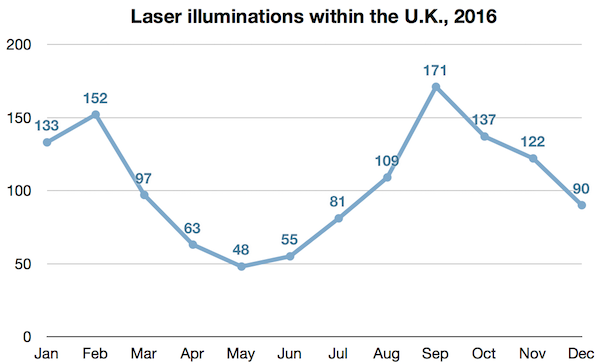
CAA listed the top 10 locations reporting laser incidents for 2016. It is not known whether these incidents all occurred at or near the indicated airports, or whether this also includes incidents (such as helicopter strikes) that occurred elsewhere but which were tallied to the closest airport.

As in the United States, the majority of laser illuminations were reported to be green. The figures below are for U.K. incidents; the color distribution is roughly the same for overseas incidents as well.
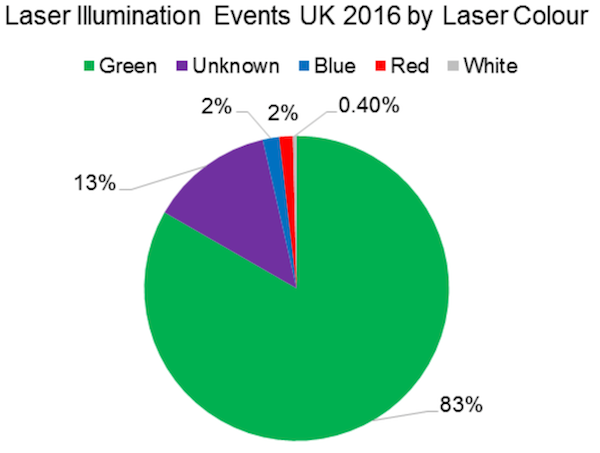
From a February 2017 report by the Civil Aviation Authority. This report contains additional details such as a monthly breakdown for each year 2009-2016, and for each of the top 10 home and overseas locations in 2016.
US: Study shows FAA-reported eye effects or injuries for four recent years
The data shows that pilots reported eye effects or injuries in less than 1% of laser illumination incidents. Flashblindness was the most-reported effect, followed by “Pain, burning or irritation in eye.” Blurriness was also frequently listed, along with unspecified “eye injury.”
In 20% of eye effect/injury cases, the person affected sought medical attention.
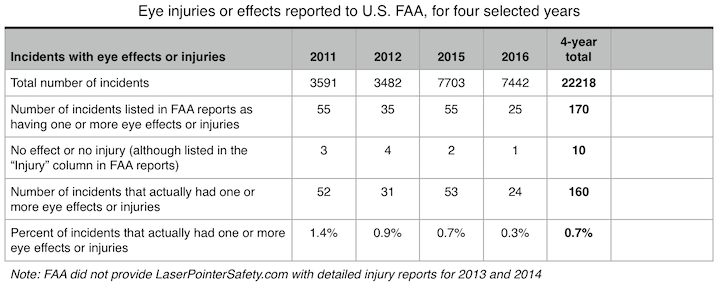
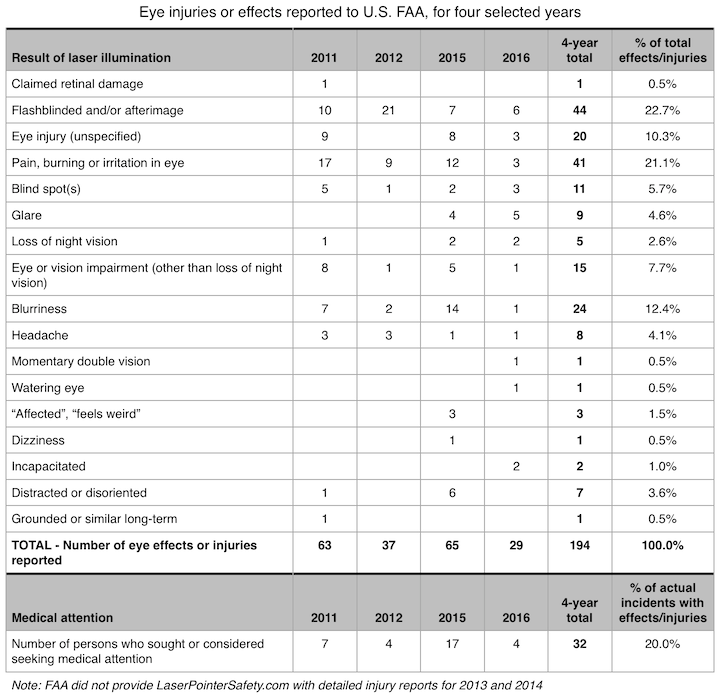
From the FAA weekly Laser Report
US: UPDATED - 7,442 laser incidents in 2016; slight decrease compared to 2015
According to FAA data, there were 7,442 laser illuminations reported by pilots in 2016. This is a slight decrease of 3.5%, compared to 2015. However, both 2015 and 2016 had far more incidents than the previous four years, 2011-2014.
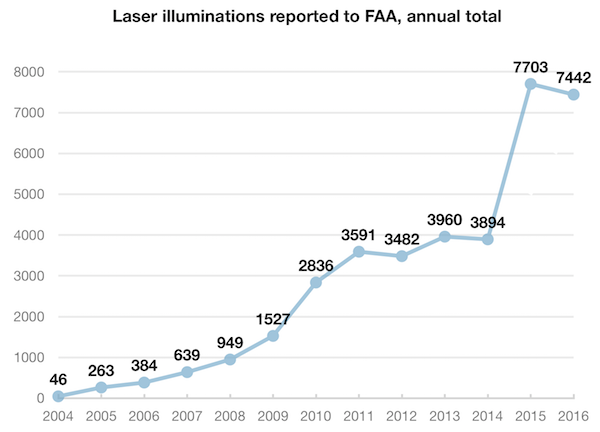
Here is the same data, arranged to show the average number of incidents per day:
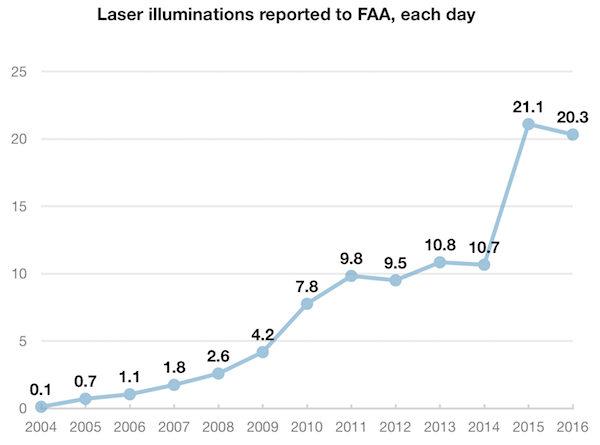
Laser color(s)
As in previous years, green was by far the most-reported color:
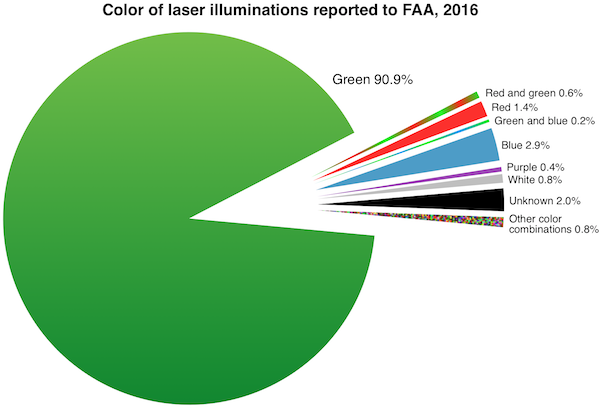
An October 2016 U.S. Food and Drug Administration proposal would allow the manufacture of laser pointers only in the 610-710 nanometer wavelength (orange-red to deep red). This chart shows the 2016 laser illuminations arranged according to those colors:
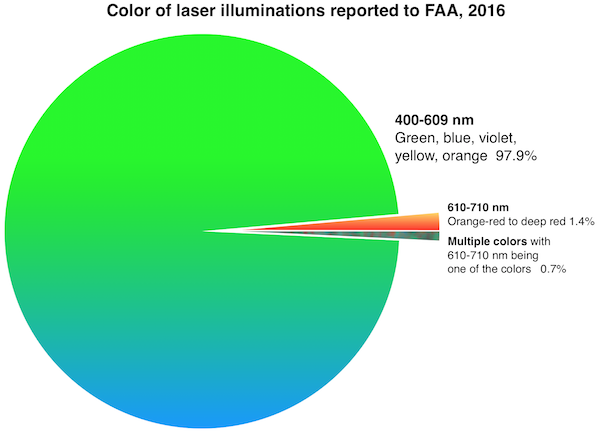
Eye injuries or effects
There were 24 laser illumination incidents in 2016 where eye effects or injuries were listed. This is 0.32% of the total number of incidents. These are the effects listed; the total adds up to more than 24 due to multiple effects in some cases.
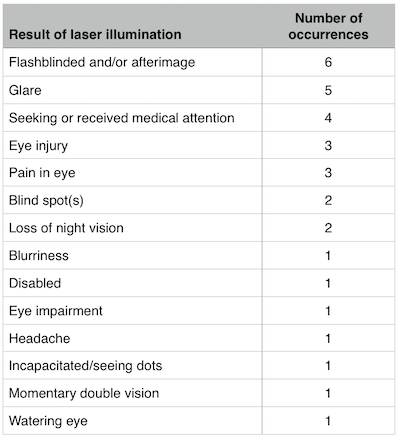
From the FAA weekly Laser Report, January 9 2017 with data January 1 - December 31 2016
US: Amazon aggressively lowers pricing on Star Shower home laser projectors
A December 14 2016 article in the Wall Street Journal describes a price war between sellers of the updated Star Shower Motion, which adds movement to the laser dots.
The list price from Telebrands was $49.99. It appears they lowered the price to around $35, then Amazon and other retailers lowered their prices to $31-33. The wholesale price of the Star Shower Motion is around $30, meaning that Amazon is barely making money on selling this laser projector.
For consumers this may be good news. However, Telebrands is watching a major distributor undercut its own pricing. And, the lower prices are putting more laser projectors in the hands of consumers.
From the Wall Street Journal (subscription required). Summary at Consumerist. LaserPointerSafety has run previous stories about he Star Shower, since they first became popular in 2015. Click for stories about aviation incidents and for general stories about the lights and their potential hazards.
Portugal: Irish investigators ask Portugal to make aiming lasers at aircraft illegal
This was the sole recommendation resulting from a September 5 2015 incident when the two pilots in a Ryanair flight, on approach to Porto Airport, were illuminated by laser light. The pilot flying was distracted and had to use his hand to shield his eyes. The pilot monitoring had temporary flash blindness lasting a few seconds. This contributed to the aircraft’s approach being “unstable.” The pilots executed a missed approach and did a go-around for a second approach; the plane then landed safely.
Portuguese officials told the Irish investigators that there is no law in Portugal against aiming a laser at an aircraft.
In 2014, there were 294 laser incidents reported in Portugal; in 2015 there were 264 such incidents. In 2014, 107 of the incidents occurred at Porto Airport; in 2015 there were 105 incidents at the airport.
From the Irish Examiner
US: FAA Eastern Region warns against holiday & Christmas laser light display misuse
The full text of the statement is as follows:
“The FAA’s concern is that lasers -- regardless of the source -- not be aimed at aircraft where the beams can threaten the safety of a flight. Consumers who buy laser light displays should take precautions to make sure that the lights are hitting their houses and not shining off into the sky. In situations such as this, we would start by asking the person to either adjust them or turn them off. For more information on lasers, please go to www.faa.gov/about/initiatives/lasers/“
From an FAA Eastern Division email to LaserPointerSafety.com, and from the Boston Globe. LaserPointerSafety has run previous stories about Christmas and holiday laser lights such as the Star Shower, since they first became popular in 2015. Click for stories about aviation incidents and for general stories about the lights and their potential hazards.
US: Airport police can go off property to find laser attackers
The measure aims to address people pointing lasers at planes that are taking off or landing and the proliferation of drones near airports. It was signed Tuesday November 22 2016 by Gov. Rick Snyder.
The lasers often are used off airport property but directed at planes while in protected airspace. The beams can fill cockpits with green light and temporarily blind pilots or blur their vision.
From the Detroit Free Press, November 23 2016.
Note from LaserPointerSafety.com: We have been unable to find details about this law. For example, a search of the Michigan Legislature website for bills introduced in 2015-2016 with “laser” as a keyword did not appear to turn up any relevant text. For example, adding “airport” as a search term found no bills at all. A similar search for completed signed bills (“Public Acts”) found a list only with entries prior to August 2016. If anyone has more details about this bill, please contact us.
Northern Ireland: "Laser Lunacy" drama visits schools to warn students not to aim lasers at aircraft
According to an October 19 2016 story in the Irish News, the performance depicts an aircraft crew member being blinded, which leads to a crash that injures 17 people. The subsequent investigation highlights how a criminal conviction can ruin a young person’s life.
After the performance there is a question-and-answer session to reinforce the message.
BIA’s Jaclyn Coulter told the newspaper “We have a very serious message to get across to young people and we thought that the most effective way of doing that was through drama…. [W]e are delighted with the response we have had both from schools and pupils. We want this practice to be stamped out. It is not fun. It is not a game.”
There were 35 aircraft illumination incidents last year, and 16 thus far in 2016.
From the Irish News
UK: Statistics on police helicopter laser attacks; one has been struck 100 times "over the last year"
Assuming “over the past year” means “in the last 12 months”, that would be an average of about two laser illuminations per week.
A separate article from BBC News states that in 2015 there were 91 reported laser illuminations of National Police Air Service aircraft. The largest number was 20 attacks against NPAS helicopters taking off from its Carr Gate headquarters near Wakefield, West Yorkshire.”
Reasons for the apparent discrepancy in numbers are not clear. It may be that South Yorkshire is not a member of the NPAS, which provides centralized air support to local police forces.
The BBC News chart below shows the 2015 NPAS laser attacks:
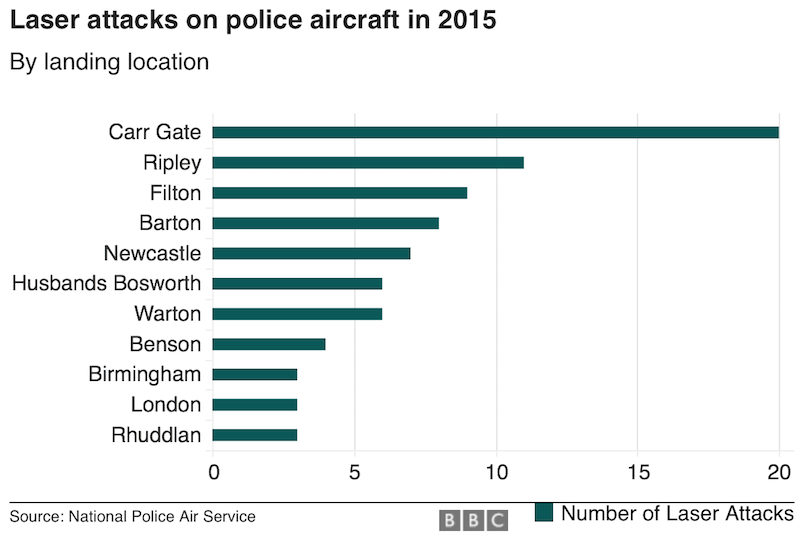
The NPAS is testing laser protective eyewear, as a means to help protect flight crews.
From The Star and BBC News. Interestingly, a September 14 search of the South Yorkshire Police website, to find more information about these incidents and police concern regarding lasers, did not find any results when searching for the term “laser.”
UK: BALPA calls for high-powered lasers to be treated as offensive weapons
BALPA noted that there were 1,439 reports of laser attacks in 2015, and that 55% of pilots experienced a laser attack in the past 12 months. A spokesperson said BALPA “has been campaigning for a long time for high-powered lasers to be treated as what they are — offensive weapons.”
The association was also concerned with the threat of incidents involving drones.
A motion to ask for improved regulations passed at the meeting.
From a BALPA press release
Ireland: Laser incidents decline over past two years
In 2014 the State Airports (Shannon Group) Act made it illegal to aim laser pens at aircraft. According to the Irish Examiner, “Since the legislation was introduced, there has been a significant decrease in the number of laser incidents reported by Irish pilots in Irish airspace to Irish Air Traffic Control.”
As of August 26 2016, there were 31 reports of lasers deliberately pointed at aircraft in Irish airspace. If the remainder of 2016 continues at that rate, there would be about 47 laser incident reports for the entire year.
Except for mentioning the 2014 legislation, the news report did not indicate any other reason for the decline.
From the Irish Examiner
Vietnam: Proposal to make it a crime to aim a laser at an aircraft
In three airports in Ho Chi Minh City, Hanoi and Pleiku, there were six incidents where lasers were aimed at aircraft between May 28 and June 14 2016. The perpetrators remain unknown as of July 6 2016.
From Vietnamnet.vn
US: Statistics for second half of 2015 show unusual rise and sudden decline
The chart below, showing FAA laser illumination reports for the past nine years, demonstrates how the number of reports increased and even more dramatically decreased (yellow area):
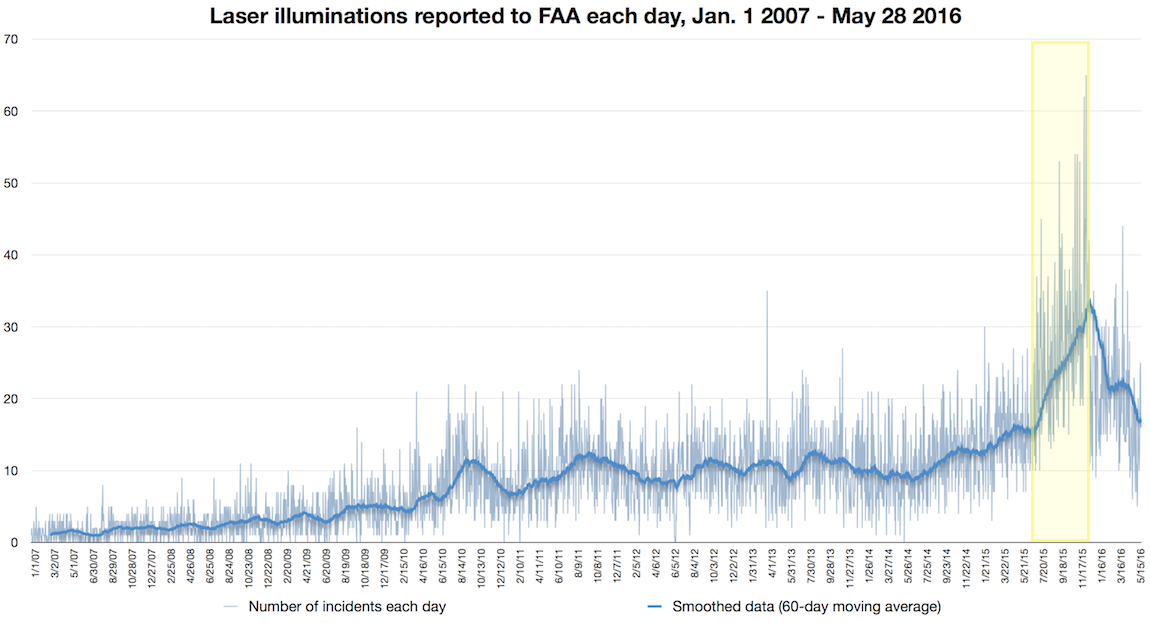
Click for larger image
A closer look at the past two years shows this more clearly:
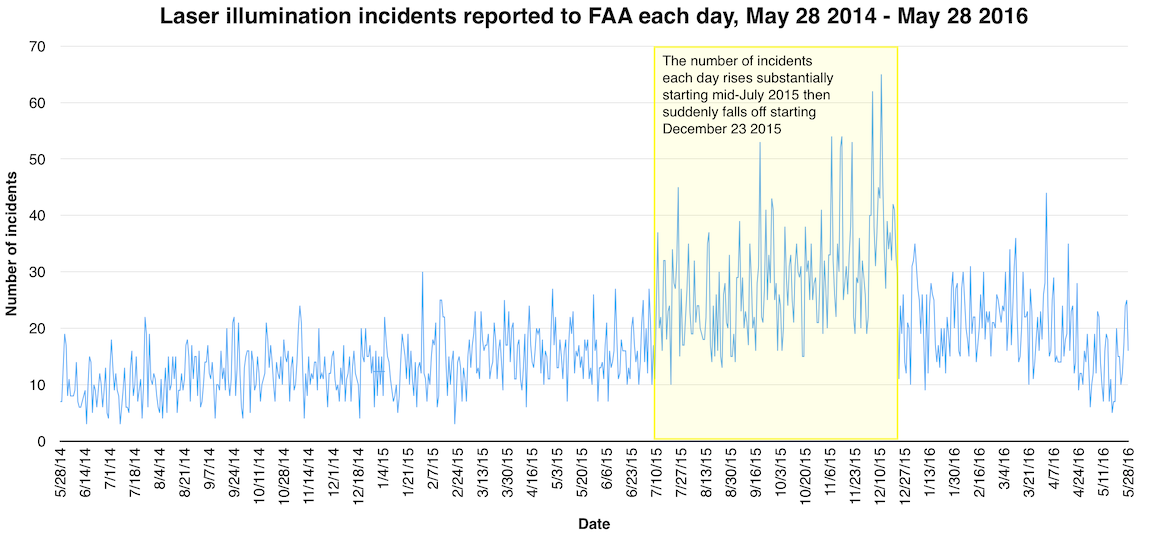
Click for larger image
A possible cause of the increase is that on July 16 there was widespread nationwide publicity about 11 flights that were illuminated on July 15 in and around New Jersey.
However, this event is not a full explanation. While the publicity may have triggered a “copycat” effect, incidents had been increasing at least two weeks prior to July 16.
LaserPointerSafety.com is not aware of any other external events such as new laser pointer products, changes in laws, etc. that could also account for this increase. And, we have no explanation for the dramatic fall-off starting December 23. We have reached out to FAA to find out if there were any changes in pilot reporting requirements or in data gathering procedures.
Knowing reasons for the increase — and especially for the sudden decrease — could provide clues in the effort to reduce laser pointer incidents in the U.S.
US: UPDATED - 2016 laser incidents up 33% over same period in 2015
From January 1 through May 28 2016, pilots filed 2,925 reports of laser illuminations with the U.S. Federal Aviation Administration. This is a 33% increase over the 2,194 reports filed during the same period in 2015.
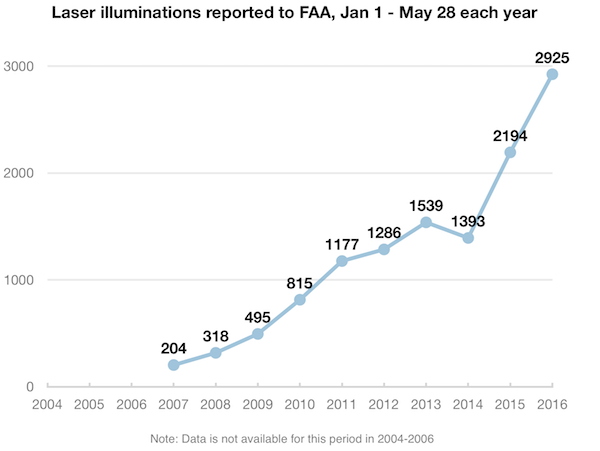
LaserPointerSafety.com estimates there will be over 8,500 laser incidents reported for 2016. This is based on comparing the number of illuminations Jan 1 - May 28 2016, with the average of the same period in the past four years.
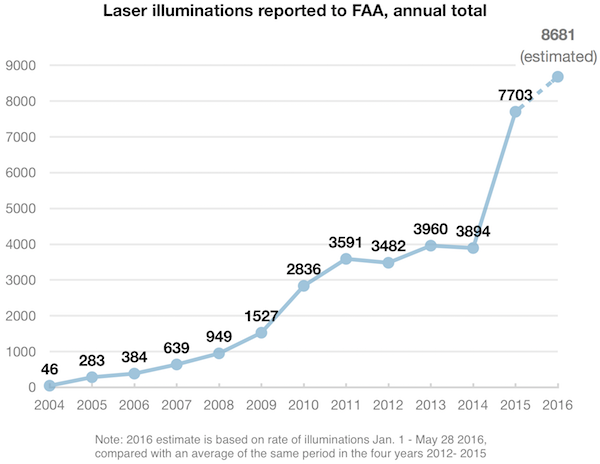
Australia: Study shows laser pointers are #2 cause of pilot incapacitation
There were 113 flight crew incapacitations in Australia during the study period — an average of about 23 per year. Of these, 15 (13.3%) of the reported incapacitations were due to laser strikes.
The study looked at “high-capacity” and “low-capacity” air transport, as well as general aviation.
During the study period there were 1,316 laser strikes reported to the ATSB in high-capacity operations. Of these, eleven (0.8%) of the laser strikes resulted in flight crew incapacitation.
A summary of the ATSB study is here. The full 30-page PDF document is available online from ATSB or from a local copy here at LaserPointerSafety.com.
Australia: Laser incidents rose 2007-2012; fell from 2013-2015
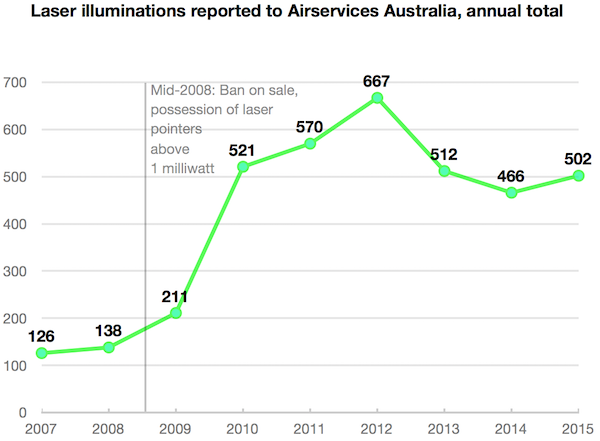
Compare this with the number of illuminations in the United States over the same period:
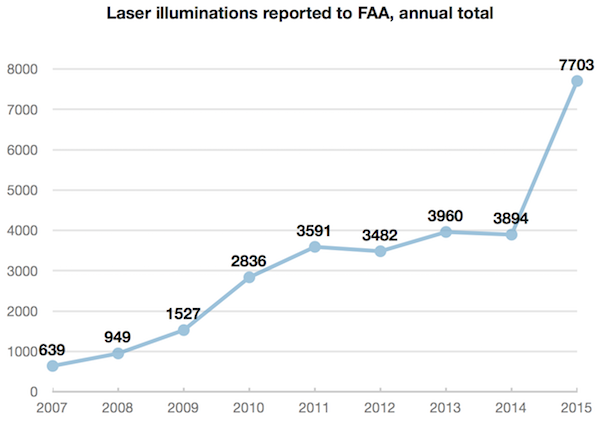
Australia’s data roughly tracks the U.S. data during the period 2007-2012. Here are the two charts above, superimposed, with the Australia numbers multiplied six times. The slope of the lines are similar for the first six years.
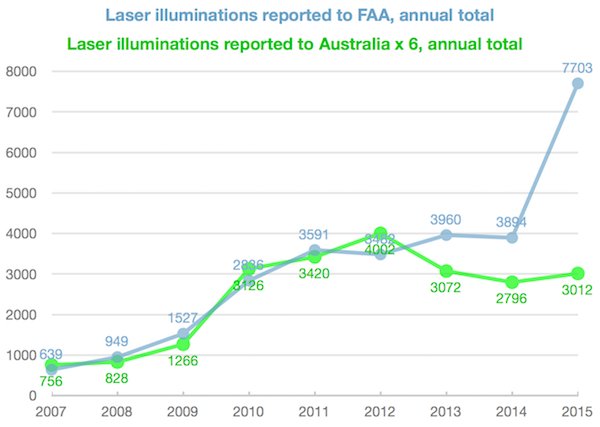
Data from Airservices Australia, a corporation owned by the Australian Government whose services include air traffic control and aeronautical data. The information was provided in response to a LaserPointerSafety.com media inquiry. Thanks to Amanda Palmer for her assistance with the request.
UK: Government department in talks to possibly withdraw high-powered lasers
The meeting is scheduled to occur during the week of February 22-26. A department spokesperson said on February 16 that it was too early to discuss any potential changes to laws.
From the Telegraph
UK: BALPA calls for "more action" after Virgin Atlantic flight diverts back to takeoff airport
The following is from the BALPA website, Feb. 15 2016. More news items referencing BALPA are here.
LASER INCIDENT SHOWS MORE ACTION IS NEEDED
15/02/2016
Last night’s laser attack incident clearly shows why more needs to be done to tackle the growing use of lasers against aircraft.
The crew of Virgin Atlantic flight VS25 bound for New York took the decision to return to Heathrow after reportedly being attacked with a laser shortly after take off.
Jim McAuslan, General Secretary of BALPA, said,
“This is not an isolated incident. Aircraft are attacked with lasers at an alarming rate and with lasers with ever-increasing strength.
“It is an incredibly dangerous thing to do. Shining a laser at an aircraft puts that aircraft, its crew and all the passengers on board at completely unnecessary risk.
“Modern lasers have the power to blind, and certainly to act as a huge distraction and to dazzle the pilots during critical phases of flight.
“We are sure the police will do everything in their power to find the culprits of this attack and prosecute them.
“We repeat our call to the Government to classify lasers as offensive weapons which would give the police more power to arrest people for possessing them if they had no good reason to have them. This incident shows why this is becoming more-and-more urgent.
“Pilots across the world know how dangerous laser attacks are and therefore will join with me in commending the actions of the crew of VS25 who put their passengers’ safety first and took the decision to return to Heathrow.”
UK: Around 9,000 laser incidents, Jan 2009 - June 2015, according to CAA
For comparison, in the United States from January 1 2009 through May 31 2015, there were 21,414 laser incidents reported to the Federal Aviation Administration. (An additional 457 incidents were reported during June 2015.) From January 1 2004 through December 31 2015 there were 29,097 laser incidents reported to FAA.
U.K. information from the Daily Mail. U.S. information from FAA data.
Canada: 61 pilots studied after laser exposure; no problems found
Examinations were done within three days of the strikes: “Early Treatment Diabetic Retinopathy Study visual acuity, colour vision, visual fields, intraocular pressure, slit-lamp examination, dilated fundus examination, colour fundus photographs, and ocular coherence tomography.”
The paper concluded, “Our study revealed that laser strikes on aircraft did not result in permanent visual functional or structural deficits. However, laser strikes cause immediate visual effects, including glare, flash blindness, and ocular irritation that can interfere with a pilot’s visual function.”
From the Canadian Journal of Ophthalmology, December 2015, Volume 50, Issue 6, pages 429-432. For the full abstract of the study, click the “Read More…” link.
Click to read more...
US: UPDATED - Laser incidents nearly double in 2015 to 7,703
he number of FAA-reported laser incidents nearly doubled in 2015, to 7,703. This is a significant increase over the 2010-2014 period, which had hovered around 3,500-4,000 incidents per year.
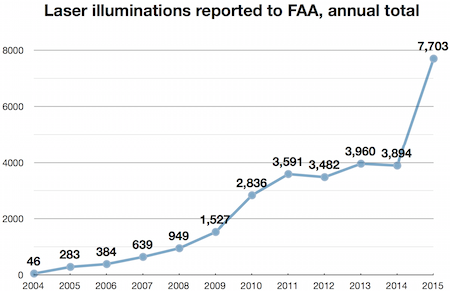
Here is the same data, presented to show the number of incidents per day:

Below is a closeup of the 2014-2015 data. The thin light blue line represents the number of incidents on each day. Note the wide variability, from as few as no reports in a day (May 27 2014) to as many as 65 on December 11 2015.The thick blue line is a 30-day moving average, to smooth out the data.
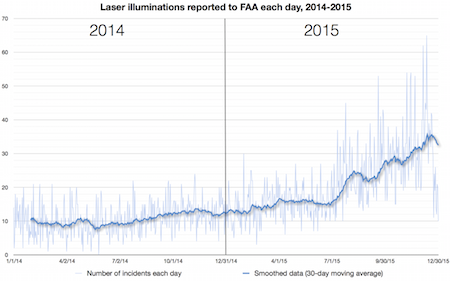
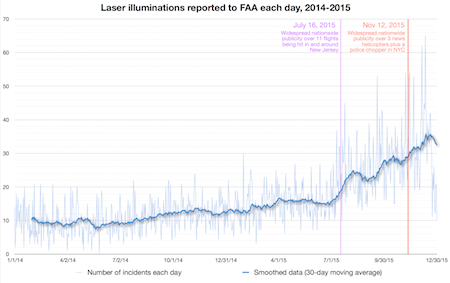
Both charts show identical data. On the second chart, two dates have been highlighted. Around July 1 2015, the number of incidents per day (light blue line) starts to increase. The only significant change that LaserPointerSafety.com can find around that time, is that on July 16 (purple line) there was widespread nationwide publicity about 11 flights that were illuminated on July 15 in and around New Jersey.
However, this event is not a full explanation. While the publicity may have triggered a “copycat” effect, it is apparent from both the thin and thick lines that incidents had been increasing at least two weeks prior to July 16.
Another date with widespread nationwide publicity is marked, November 12 2015 (red line). Three news helicopters and a police helicopter were illuminated in New York City the night before. Again, while there is some increase in incidents after that date, there also was a consistent increase from July through November.
Based on this analysis, “Copycat” laser use does not seem to be a significant factor in the near-doubling of 2015 laser incidents.
UK: UPDATED - Medical report on commercial pilot injured by blue laser at 1300 feet
“An airline pilot presented to our department complaining of a blind spot in the upper left area of his visual field in the right eye (right supero-nasal scotoma) following exposure to a laser beam while performing a landing maneuver of a commercial aircraft. At around 1300 ft (396 m), a blue laser beam from the ground directly entered his right eye, with immediate flash blindness and pain. Spectral domain ocular coherence tomography highlighted a localized area of photoreceptor disruption corresponding to a well demarcated area of hypofluorescence on fundus autofluorescence, representing a focal outer retinal laser injury. Fundus examination a fortnight later revealed a clinically identifiable lesion in the pilot’s right eye commensurate with a retinal-laser burn.”
The paper said the pilot’s symptoms “fully resolved 2 wk later” and that there was no “deficit in visual function.”
Click to read more...
US: Study of U.S. incidents, 2010-2014 gives insights into laser-aircraft safety
An AirSafe summary noted that from 2010 through 2014, there were only eight days with no laser encounters reported in the U.S. The graph below shows the distribution of incidents, with most days having between 7-12 laser strikes:
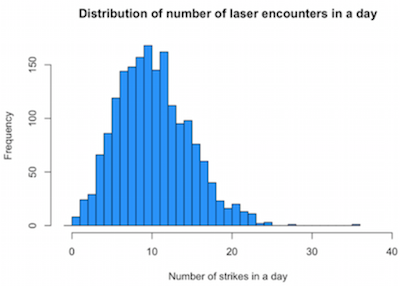
Analysis by day of the week, and by month of the year, showed Friday and Saturday evenings as having a greater likelihood of illuminations. July through November saw higher-than-normal numbers of incidents.
The AirSafe study also looked at six selected metropolitan areas. It compared the number of flights to the number of incidents. Phoenix, Los Angeles and San Francisco had higher-than-normal numbers of incidents; Chicago and New York were about average, and Atlanta was below average.
From AirSafe.com: summary page, and detailed analysis as a webpage, PDF and RPubs versions. Links are given to the raw FAA data, the processed version used by AirSafe, and statistical R code. Thanks to Dr. Todd Curtis who did the study and brought this to our attention.
US: UPDATED - "Star Shower" home laser projector raises aviation concerns
Between November 18 and December 6 2015, there have been at least three incidents, involving six aircraft, where pilots were illuminated with light from “Star Shower” laser projectors. In all cases, the illumination appeared to be inadvertent. The devices were being used for holiday decorating, and stray beams went into airspace. (E.g., a person was not knowingly aiming the Star Shower at an aircraft, or the flight path of an aircraft.)
The Star Shower emits “thousands” of laser beams from two sources, one green and one red. A homeowner can simply aim the Star Shower at her house or foliage, and instantly cover it with green, or green plus red, laser dots.
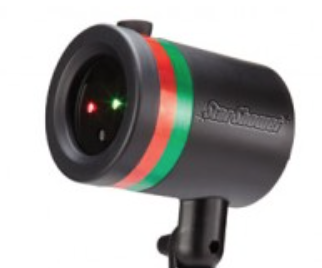
The projector head. It screws into a stake that is placed in the ground for outdoor use.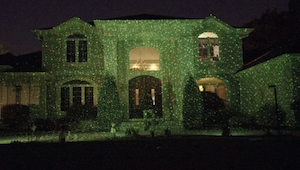
A home densely covered with laser “stars” from multiple Star Shower projectors. Both photos from the Star Shower website.
According to a comprehensive story in Inquisitr, Star Shower is so popular that it is sold out in many locations. TravelPulse calls it a “laser cannon.”
The Federal Aviation Administration on December 8 2015 tweeted “Decorating for the holidays? A stray laser could blind a pilot.” They then provided a link to general information about laser/aviation safety. An FAA spokesperson told CBS Philly, ““I don’t think anybody who buys these devices even think they have enough power to hit an aircraft in the sky…. If the box is aimed a little high, some of the lasers will not hit the roof of the house, they’ll keep going into space.”
While there is no warning on the outer packaging, the Star Shower instruction sheet says: “NOTICE: Lasers should not be projected at or within the flight path of an aircraft within 10 nautical miles [11.5 miles] of an airport. If your intended surface is within 10 nautical miles of an airport, lower the angle of the Star Shower so that no lasers point into the sky.”
In a December 9 2015 statement to NBC Los Angeles, the manufacturer added: “Star Shower Laser Lights operate by taking a single laser beam and diffracting it into thousands of individual laser beams. Each beam emitted by Star Shower is much lower in power than a typical laser pointer. Each individual laser beam is 10 times less than the maximum permissible exposure (MPE) allowed by the FAA normal flight zone (NFZ) criteria.”
In an urban or suburban environment, it is likely that most homes are within 10 NM of some type of airport. It may not be a major metropolitan airport; it could be a small general aviation facility. In a December 3 2015 incident, a Boeing 737 at 13,000 feet and 22 miles east of Dallas-Fort Worth Airport, reported seeing lights from what was believed to be a “laser holiday light display.”
From the FAA, Inquisitr, NBC Los Angeles
Analysis and commentary by LaserPointerSafety.com
ADVICE FOR OUTDOOR USE
After purchasing and testing a Star Shower, here is our summary advice for consumers. Details then follow.
The Star Shower is essentially eye-safe, and does not cause direct interference (glare) with pilots’ vision after about 411 feet. However, a single beamlet can be a distraction to pilots at least 3/4 of a mile away, and possibly further away due to the large number of laser dots aimed into the sky causing a flashing effect.
For this reason, a Star Shower needs to be aimed so that beams don’t go into airspace. You do not want an officer knocking on your door because a pilot saw and reported your home laser projector. While it is unlikely you would be arrested for an unknowing aircraft illumination, federal penalties for laser pointer misuse range up to five years in prison and up to a $250,000 fine.
Putting the projector closer to a house will keep more of the beams on the structure. Similarly, don’t aim it up into a tree unless the tree is very dense, such as an evergreen.
It should also be noted that there are reports such as this and this of Star Showers being stolen from yards. If you put your projector on a roof or up in a tree, aiming downwards, this both helps aviation (no beams going up into the air) and makes it harder to steal the projector. Finally, if you are in a heavy air traffic area, you might want to consider restricting it to indoor use only.
IS A STAR SHOWER LEGAL?
Under U.S. federal law, the Star Shower is legal to own and operate. As a Class IIIa (3R) laser, there are no federal restrictions on its use. The federal law prohibiting laser pointer misuse may not apply, for two reasons. 1) It prohibits knowingly aiming at an aircraft or its flight path, and 2) the law applies to “laser pointers…designed to be used by the operator as a pointer or highlighter….” This definition would not seem to apply to a device that is not a pointer, and is not used “…to indicate, mark, or identify a specific position, place, item, or object.”
A few states or localities may have restrictions on lasers that would affect Star Shower. Since it is not a laser pointer, and is not used for pointing, restrictions that cover laser pointers may not apply (depending on the exact definition). Some selected state and local laws are here.
Common sense says that a person should not stare into the beams, and that they should not be aimed to harass others. Similarly, the beams should not be aimed down a road or up into the sky, where they could interfere with drivers or pilots.
PURCHASING AND PACKAGING
In early December 2015, we purchased a Star Shower for $40 from a CVS drugstore. The box lists a sales website at BulbHead.com, and the distributor as Telebrands. It also says “Made in China.”
Both the box and the device have the proper FDA-mandated laser safety labeling. The device is FDA Class IIIa, meaning less than 5 milliwatts output. There are two apertures, one for 532 nm green laser beams and one for 650 nm red beams. A diffraction grating in front of each laser breaks the single beam into dozens or “thousands” of less-powerful beamlets. In a foggy or smoky environment, it is possible to see the beamlets in the air, but they are too weak to be seen in clear air.
Although the Star Shower has been popular for the Christmas 2015 season, the packaging does not emphasize this. Instead it says the Star Shower is “great for” indoor, landscaping, holiday, winter and summer uses. The advantages are: “No ladders, no hanging, no dead bulbs, no mess — just plug it in.”
TESTING
We took it to laser expert Greg Makhov of Lighting Systems Design Inc. for testing. Keep in mind that he tested just this one sample unit; we assume it is representative of the other Star Showers that have been sold.
Makhov used two different types of power meters, both which could measure in the microwatt and milliwatt region. He found that the maximum power of a single beam was 0.4 milliwatts. The chart below shows details.
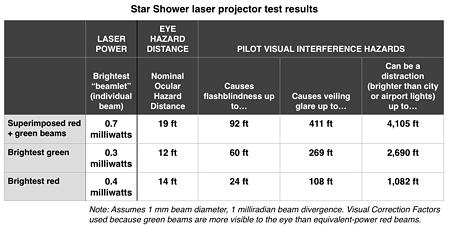
ESSENTIALLY NO EYE INJURY HAZARD
The brightest single beam, at 0.4 mW, is below the 1.0 mW Class II limit. Class II laser pointers are generally considered to be safe for accidental exposure. Eye injury from a Star Shower would be almost impossible unless a person at close range deliberately overcame his aversion to bright light and stared for many seconds into one of the beamlets, keeping it at the same spot in his visual field.
While the chart shows the Nominal Ocular Hazard Distance to be as far as 19 feet, keep in mind this is a “nominal” hazard. This does NOT mean that beams will cause injury at this distance. There is a kind of safety factor built in to the NOHD. A quick approximation is that at about 1/3 the NOHD (about 6 feet in this case), there is a 50-50 chance of a laser kept steady on the eye causing the smallest medically detectable lesion on the retina, under laboratory conditions.
GLARE UP TO 411 FEET, DISTRACTION TO 3/4 MILE
The chart also shows the visual interference hazard distances. For example, a pilot could experience veiling glare (she can’t see past the light) up to 411 feet away from the Star Shower projector. The light does not interfere with vision, but is a mental distraction, up to 4,105 feet away — a little over three quarters of a mile.
The above eye and visual interference calculations are for a single beamlet, for two reasons. First, at aviation distances, only one beamlet would enter the eye at a time. They are not so close together that two separate beamlets of the same color would be within one pupil diameter. The second reason is that even a person is so close to the Star Shower that two separate beamlets enter his pupil, each one will be focused onto a different area of the retina. This means that the beams don’t overlap — they are heating different areas. This is why we are primarily concerned — both for eye safety and for aviation interference — with the hazard of a single beamlet.
Now, when a helicopter flies through the dozens or “thousands” of laser beams, this can be more distracting than a single beam. It is no wonder that a pilot might report the laser display, and have it re-aimed or shut down.
Although an FAA spokesperson said a Star Shower was reported by a pilot who was at 15,000 feet, at this distance any single beamlet would be far below the FAA’s distraction limit. This means any beamlet would be no brighter than surrounding city or airport lights. It could be that the large number of beamlets caused flashes as the aircraft flew through them, and that this flashing was itself a distraction. Either way, no competent pilot at 15,000 feet should have any visual interference from a Star Shower. The only problem could be mental distraction, if the pilot paid more attention to the light than to flying the aircraft.
DISASSEMBLY AND HACKING (UPDATED DECEMBER 2016)
In early December 2016, Julius R. wrote to us wondering about the safety implications of opening the Star Shower and removing the star-creating holographic diffraction grating.
Our Star Shower, purchased in December 2015, has four security screws hidden behind rubber caps. The screws are at the bottom of a 2-1/4” deep shaft that is 5/16” in diameter. The screw head shape is a triangle with a raised dot in the center: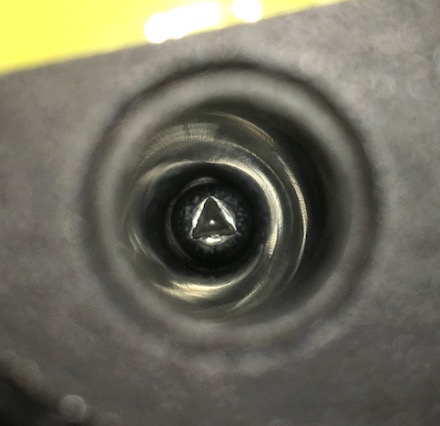
It would require a long screwdriver with a matching tip to reach and undo the screw. A brief search of Google Images to try to find such a screwdriver did not turn up any instances.
Certainly someone might be able to find such a tip, or to grind a shaft to fit. And breaking the Star Shower’s plastic housing could also give access to the inside. So if someone really wanted to get at the interior lasers, it would be possible.
We estimate that each of the lasers on the inside would be in the 10 to 50 milliwatt range. This power can cause an eye injury, although the injury would be relatively minor (assuming an unintentional exposure; deliberate staring into any laser beam should never be done). It is at the low end of Class 3B lasers.
There are similar lasers, and much more powerful ones, readily available online. They would be cost the same or even less, and would be much easier to use. So a laser hobbyist or hacker is unlikely to use a Star Shower as a source for red and green single-beam lasers.
In short, disassembly and misuse of the interior lasers is not a significant safety concern.
FOR FURTHER INFORMATION
Anyone with further questions can contact us; click the link below in the footer at the bottom of the page.
UK: 400+ laser incidents in the first half of 2015
From January 1 to June 30 2015, there were more than 400 laser incidents reported to CAA. Heathrow had the most incidents by count, with 48 in the first half of the year. (This is actually fewer incidents per month than last year, when there were 168 total Heathrow laser reports for all of 2014.)
By proportion of laser incidents to air traffic volume, there was a higher frequency of attacks at regional airports such as Birmingham, East Midlands, Leeds Bradford and Newcastle.
The British Airline Pilots’ Association (BALPA) on November 2015 released the results of a survey of its pilot members, showing that 50% had reported a laser/aircraft incident during the period from November 2014 to November 2015.
From the Guardian and the Express. The CAA and BALPA statistics were released along with news of a British Airways pilot who reportedly suffered severe retinal injury from a spring 2015 exposure to a “military-strength” laser.
US: Slightly more than average number of laser incidents grabs media attention
Except for the involvement of multiple helicopters in New York City, the twenty November 11 overnight events were actually close to the current 2015 average of the 18.3 reported incidents per night.
It is normal for day-to-day incident numbers to fluctuate. For example, a day later on November 12, there were six incidents according to Slate.
Another example of the variability of daily incidents is shown by the day-to-day numbers for 2014. During the year there was an overall average of 10.7 incidents per day. The graph shows that daily numbers (light line) varied from 0 reported laser incidents to 24. (The dark line shows a 30-day moving average, to help smooth out the data. Day-to-day figures for 2015 are not yet available.)

The U.S. Federal Aviation Administration made a Facebook post describing the November 11 incidents:
More than 20 aircraft were struck by lasers from the ground last night while flying over cities across the United States. Three laser strikes were reported in the New York City/Newark, N.J early in the evening, followed by three incidents in Texas, where jets were struck while preparing to land at Dallas Love Field. By late evening, pilots reported laser incidents in:
New York/Newark; Dallas; Jamestown, NY; Oakland, CA; Covington, KY; Danville, KY; Palm Springs, CA; Salt Lake City; Los Angeles; Albuquerque; Detroit; Ontario, CA; St. Petersburg, FL; Springfield, IL; San Juan, PR; Sacramento
None of the pilots reported injuries. Nevertheless, shining a laser at an aircraft is a federal crime that the U.S. vigorously pursues. Lasers distract pilots from their safety duties and can lead to temporary blindness during critical phases of flight, such as takeoff and landing. In some cases in the past, pilots have reported eye injuries that required medical treatment.
As of Oct. 16, the total number of laser strikes around the U.S. this year was 5,352.
Media stories that referenced the incidents included the following headlines and leads:
With new flurry overnight, laser strikes on aircraft hit record pace, USA Today
“Laser strikes on planes are growing even as the federal government enacts tougher penalties for people caught shining the devices. Overnight Thursday federal authorities fielded reports of more than 20 laser strikes on aircraft, adding to an already record-breaking number of strikes this year.”
Overnight outbreak of lasers pointed at aircraft, CBS Evening News
“The FAA says 20 aircraft were targeted by people with bright laser pointers Wednesday night in cities across the nation. Kris Van Cleave reports on the surge in these types of incidents.”
FAA: Lasers beams hit more than 20 aircraft overnight, Washington Post
“Federal authorities have launched an investigation after numerous aircraft were hit by laser beams Wednesday night. More than 20 aircraft were struck while in flight over at least 16 U.S. cities, according to a statement from the Federal Aviation Administration. Authorities said three strikes were reported to the FAA in the New York City area, followed by three in Texas that hit jets that were preparing to land.”
Lasers hit 20 aircraft flying in U.S. overnight - FAA, Reuters
“Dangerous beams from handheld lasers struck 20 aircraft flying over the United States and its territories overnight, among the nearly 5,400 laser hits in the nation so far this year, the Federal Aviation Administration said on Thursday. No injuries were reported in the incidents, which took place from New York City to Sacramento, and resulted in at least one arrest. Authorities said the incidents did not appear to be linked to each other.”
6 aircraft hit by lasers in New York, Dallas on Wednesday, Fox News
“Three news helicopters in New York and three planes near Dallas were hit by laser beams on Wednesday, according to the Federal Aviation Administration. Pilots for choppers flying for CBS New York, WNBC and WABC each described seeing a laser in their cockpit while flying over a scene in Park Slope, Brooklyn, CBS reported.”
High Number Of Laser Strikes In One Night Has Pilots Uneasy, CBS Sacramento
“The Federal Aviation Administration is looking into a series of laser strikes on aircraft across the country, including a possible strike at Sacramento International Airport. The exact details of that reported laser strike have not been made available yet, but for pilots these little beams of light are a huge concern. It was a busy night for law enforcement and air traffic control across the nation, with more than 20 pilots reporting laser pointers aimed at their cockpits.”
US: From 6,500 to 7,100 laser incidents estimated for 2015
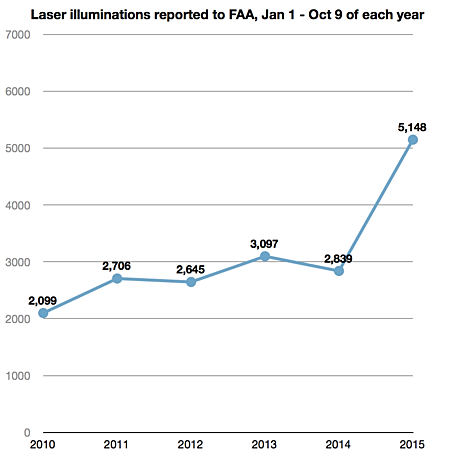
Based on trends in the years 2010 through 2014, this means that at the end of 2015 there could be between roughly 6,500 and 7,100 reported incidents. (The range is because in some years, the yearly total was between 1.28 and 1.37 times the Jan. 1 - Oct. 9 total.) We estimate that 2015 is likely to have roughly 6,850 incidents. This would be 176% of the 2014 total of 3,894 incidents.
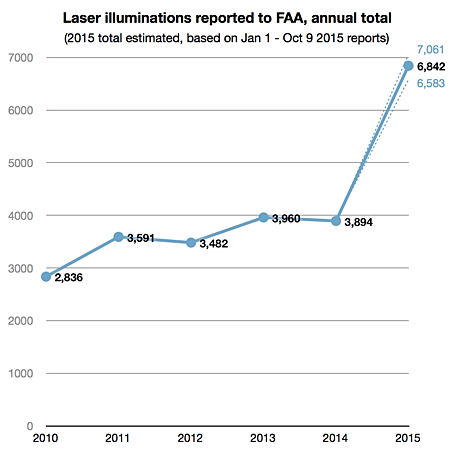
Stated on a daily basis, the number of reported incidents is expected to rise from 10.7 per day in 2014 to between 18.0 and 19.3 per day in 2015.

2015 information provided by FAA on November 5 2015. Statistical analysis done by LaserPointerSafety.com based on prior year FAA records.
US: Sullenberger says drones, laser pointers are dangerous; need certain prosecution
DICKERSON: So, the final question, Sully, I want to ask you about these reports about near misses from drones and commercial airlines. How dangerous is that?
SULLENBERGER: Well, because they are easy to get and they're relatively inexpensive, these devices are becoming ubiquitous. And that is true not just of drones, but of laser pointer attacks. And so it allows people to do stupid, reckless, dangerous things with abandon. I am heartened that the aviation and the legal authorities have raised the penalties for doing these things. Unfortunately, the essential element that is still missing is the certainty of prosecution, because it has been difficult to catch them in the act. This must stop.
DICKERSON: Very quickly, though, what could possibly happen, though, with one of these drones? I mean, how bad could it get?
SULLENBERGER: Well, we have seen what a six-pound or an eight-pound bird can do to bring down an airplane. Imagine what a device containing hard parts like batteries and motors can do that might weigh 25 or possibly up to 55 pounds to bring down an airplane -- it is not a matter of if it will happen. It is a matter of when it will happen.
Sullenberger successfully ditched U.S. Airways Flight 1549 in New York’s Hudson River in January 2009, after multiple bird strikes caused both engines to fail just after takeoff from LaGuardia Airport. Since 2011 he has been a CBS news aviation and safety expert commentator.
From the Face the Nation transcript and the Wikipedia page for Sullenberger
Canada: Saskatoon officials warn about laser pointer hazards
One pilot said that lasers have been pointed at him “at least 10 times in the past 3 years.”
A CJME news story notes that “pointing a laser at planes could land those responsible in hot water under the Canadian Aviation Regulation Act. Potential penalties range from fines of $3,000 to multi-year probation sentences and incarceration. Charges could also include mischief, assault with a weapon and assault of a police officer.”
From CJME.com and 620CKRM.com
US: Coast Guard says NJ laws have not reduced laser strikes
Delaware Online reported from the event that “[l]asers have been a point of contention in Ocean City [MD] for years, with the council deciding to ban the sale of them last summer, and make it illegal to possess a laser pointer in public. Similar laws have gone into effect in New Jersey, but the Coast Guard hasn’t seen a decrease in laser strikes, [Lt. Shawn] Glavan said.”
According to The Dispatch, “Coast Guard Station Atlantic City, where [Glavan’s] MH-65 Dolphin [helicopter] is based, handles around two or three incidents a week involving individuals shining lasers on the aircraft. Coast Guard Air Station Atlantic City’s response area covers a large swath of the mid-Atlantic including Ocean City and as far south as Chincoteague.”
From DelawareOnline, CBS Baltimore and The Dispatch
US: FAA-reported laser incidents up significantly in 1st half of 2015
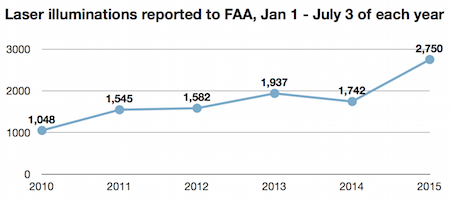
Based on past years’ trends, this means that at the end of 2015, there could be between about 5,600 and 7,400 incidents. (The range is because in some years, the second half of the year had 2.04 to 2.71 times the number of incidents in the first half.) We estimate 2015 is most likely to have about 6,300 incidents. This would be a 62% increase over the 2014 total of 3,894 incidents. 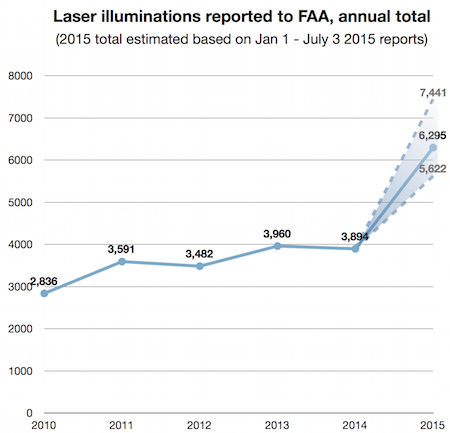
Stated on a daily basis, the number of incidents is expected to rise from 10.7 per day in 2014 to somewhere between about 15 and 20 incidents per day in 2015: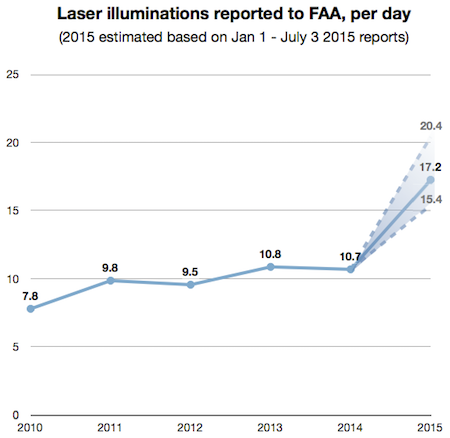
2015 information provided by FAA on July 10 2015. Statistical analysis done by LaserPointerSafety.com based on prior year FAA records.
Canada: Government launches safety campaign to warn against pointing lasers at aircraft
Helping Canadians better understand the dangers lasers pose to aircraft
The Honourable Alice Wong, Minister of State (Seniors), on behalf of the Honourable Lisa Raitt, Minister of Transport, today launched the Government of Canada’s safety awareness campaign for lasers. The national campaign will help Canadians better understand why pointing a laser at aircraft is not a bright idea.
The first phase of the campaign, unveiled today in collaboration with the Vancouver International Airport, the RCMP, and NAV CANADA, provides the public with an easy to follow infographic, which clarifies the dangers and consequences of pointing lasers into airspace and how incidents can be reported. This summer, the second phase of the campaign will include digital advertising, awareness videos and a direct mail campaign near three major airports.
Transport Canada has also launched tc.gc.ca/NotABrightIdea, which provides Canadians with the information they need to better understand the dangers of pointing a laser at an aircraft.
Transport Canada is working closely with police, other government departments, and the aviation industry to protect pilots, passengers, and people on the ground. If you see a laser pointed at an aircraft, report it to your local police.
Quick Facts
- The number of lasers pointed at aircraft is rising in Canada. In 2014, there were 502 reported incidents – a 43% increase since 2012.
- Aiming a laser at an aircraft is a federal offence. If convicted under the Aeronautics Act, an offender could face up to $100,000 in fines, 5 years in prison, or both.
- Canadians can join the conversation and learn more by using the #NotABrightIdea hashtag on Twitter.
Italy: Sharp rise in laser incidents to 1,189 in 2014
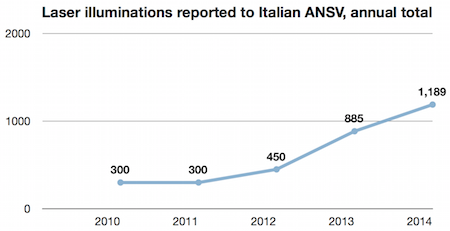
80% of the cases involved aircraft on approach, 15% involved aircraft taking off, and 5% happened during cruise.
The commander of the border police said he has never been able to identify the laser perpetrators. The fact that incidents occur in the dark, “coupled with the fact that a laser pointer can be easily hidden, makes it impossible to identify those responsible, unlike those who throw stones from the flyover. We think they are guys who do not realize the severity of what they do."
From Corriere Della Sera. Thanks to Alberto Kellner Ongaro for bringing this to our attention.
US: Survey paper says "Injury from laser pointer trauma is a public health problem on the rise"
It begins by summarizing misuse in sports, and in the thousands of incidents per year in the U.S. where lasers are aimed at aircraft.
The authors, Dr. Gregory D. Lee and Dr. David R. Lally, then write “Perhaps the greatest concerns are raised by reports of unsupervised children who have received these lasers as toys or gifts and expose themselves to the laser beams, causing permanent retinal injury with reduced central vision. From 2000 to 2009, there were five reports of 18 patients with injuries due to laser pointer exposure.”
They discuss the types of injuries (thermal, photochemical and mechanical) and locations of retinal injuries. There is a listing of laser classes, with “pointers” — Class 1, 2 or 3R (IIIa) — being distinguished from similar-looking but more powerful Class 3B and 4 “handheld” lasers.
The authors conclude as follows:
“Inappropriately used class 3B or 4 lasers should be considered weapons that can cause serious, permanent bodily injury. Even brief exposures to diffused rays of laser beams can cause temporary flash blindness that may last for hours in airline pilots, endangering the lives of passengers, particularly during takeoff and landing sequences. Cases of short-range laser exposure are becoming more common, often involving children who are inappropriately given these devices as toys, and these patients are referred to retina specialists after the damage has already occurred.
“No definitive experimental study, case report, or animal model has shown improvement in these injuries with any type of treatment, but typically these patients are treated with a short course of corticosteroids or nonsteroidal antiinflammatory drugs. Secondary choroidal neovascularization has been treated successfully with intravitreal anti-VEGF agents.13,14
“Clinicians, particularly retina specialists, can raise awareness of this rising public health issue by educating patients and parents about the hazards of laser pointers. Legislation is currently being written to impose stronger regulations on the distribution and sale of these devices. If a patient presents with findings of a laser-related retinal injury, clinicians should report the incident to the FDA so that investigations can be performed into the manufacturers of these devices. Reports can be made at www.fda.gov/downloads/AboutFDA/ReportsManualsForms/Forms/UCM236066.pdf.”
From Retina Today
US: Wall Street Journal examines link between males, laser offenders
It began by noting that in 89 of the 93 reported arrests last year for laser strikes against aircraft, the offender was male. The article quoted a New York laser safety officer, John Zelenka, as saying he has never seen a female playing with lasers.
A developmental psychologist was quoted as saying that lasers appeal to a masculine perspective. Patrick Murphy (editor of LaserPointerSafety.com) told the Journal “For a lot of guys it’s like, ‘The bigger the laser, the more visible, the more of a man I am.’”
Author Sophia Hollander then noted that the prices of a 20 mW laser dropped from $239 in 2004 to $8 in 2015.
She examined the similarity of “Star Wars” lightsabers and lasers, quoting experts on the appeal to males of a weapon that can “throw your influence.”
The online article was illustrated with photos from a lightsaber combat class held by the group New York Jedi. Actual lasers were not used in the class due to the potential hazards.
From the Wall Street Journal (article is behind a paywall)
US: FAA says no known permanent eye injuries from laser pointers as of March 2015
Commentary from LaserPointerSafety.com: There have been many pilot claims of eye injuries caused by laser pointers aimed at their aircraft. FAA has investigated some of the most serious claims. In 2011, a person knowledgeable about these studies told LaserPointerSafety (on background): “I haven't seen anything that convinces me that any of the FAA incidents are true injury. I haven't seen any convincing evidence of delayed laser lesion effects. I do know that headaches and eye pain and photophobia and light sensitivity have been reported and associated with laser illumination. I have seen nothing convincing me that there is real cellular, tissue injury.”
There have been a few cases (<10?) of temporary eye injury, where the eye healed. This is similar to how skin can heal after a sunburn. In all of these cases, the pilots returned to flying.
There have also been cases of reported laser injury to the cornea. This is the transparent surface of the eye. Visible laser light passes right through and is not absorbed. The cause of these reported “laser” injuries is the pilot rubbing his or her eyes too vigorously, causing painful scratches in the sensitive cornea. Any damage from a visible laser beam would be on the light-absorbing retina.
Note that FAA limited its statement to commercial pilots. There may be military pilots in conflict zones who have been injured by laser weapons. If so, this information would be classified. Due to the seeming lack of urgency with FAA and U.S. military, any such injuries would not seem to be a threat to commercial pilots in the U.S.
Here are lists of all LaserPointerSafety.com news items tagged with the keyword “eye effect or injury”: aviation injury incidents, non-aviation injury incidents, other eye injury stories.
LaserPointerSafety welcomes any documented cases of pilot eye injuries. Contact us with the links etc., and also contact FAA so they can be aware of the cases.
UK: 1,442 laser incidents in 2014; up 3.4% over 2013
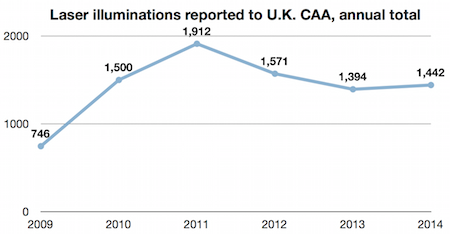
Additionally, there were 312 laser incidents that occurred outside the U.K. to U.K. operators.
In 2014, the top four most frequent incident locations were London/Heathrow (168), Manchester International (107), Birmingham (92), and Leeds Bradford (81). London/Gatwick and Glasgow were tied for fifth place, each with 64 reported incidents.
CAA published a PDF report with more detailed figures, including a monthly breakdown of the most frequent laser incident locations in 2014, and monthly & yearly totals for 2009 through 2014, and overseas (non-U.K.) incidents occurring to U.K. operators.
From the CAA PDF report dated February 2 2015. Note: There is a discrepancy where one table lists a total of 1,440 incidents in 2014 while another lists a total of 1,442. We have used the larger figure in this story.
Additional charts are on the page listing 2014 incident statistics, and the page with 2004-2014 historical data.
Canada: 502 laser/aircraft incidents in 2014
From the Transport Canada webpage Aiming a laser at an aircraft? Not a Bright Idea.
US: FAA releases spreadsheet with details of laser incidents, 2010-2014
This information was previously restricted and hard-to-obtain by the general public. The 3.6 MB Excel-format spreadsheet lists the date, time, aircraft ID, aircraft type, altitude, nearest major city, beam color, and whether an injury was reported.
The image below shows four days worth of data, January 1 through 4, 2014. Each row is one laser/aircraft incident.
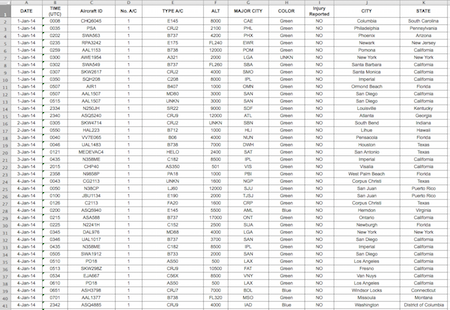
The spreadsheet, “Reported Laser Incidents for 2010-2014”, can be downloaded from FAA’s webpage Laser News, Laws, & Civil Penalties.
US: 3,894 FAA-reported laser illuminations in 2014; only 2.4% decline from 2013
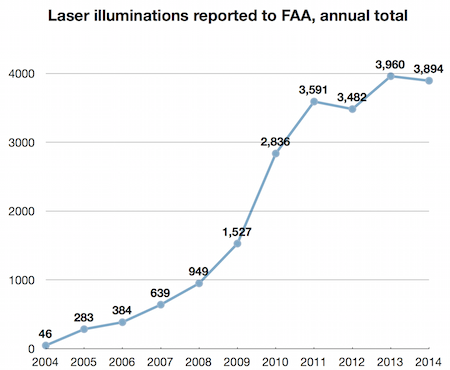
The chart below shows the number of incidents each day (light blue line) and a 30-day moving average (dark blue) to smooth out the data. In the first half of the year (Jan 1 - Jun 30) there were 9.4 incidents per day, but these rose in the second half to 11.9 incidents per day, making the 2014 final average of 10.7 incidents per day.
It is unclear why 2014 saw roughly level incident rates up to about June but then a steady increase over the next 5 months. One significant 2014 event was the February push by the FBI to publicize and prosecute laser pointer incidents, including offering a $10,000 reward. This was followed by another FBI push in June — after which rates started to rise.
The chart below shows 2014 in context with the past seven years. While the incident rates have leveled off to about 10-11 per day since 2011, all the publicity and prosecutions over the past few years have not brought the rate downward.
Finally, this chart superimposes each year’s laser illumination incidents, from 2009 through 2014. This gives an idea of the “shape” of each year. The heavy black line is 2014 data.
From public FAA Excel spreadsheet “Reported Laser Incidents for 2010-2014” at this page. For 2013 and previous years’ data, see the page FAA laser/aircraft incidents: 2004-2013 historical data.
Finland: 60+ laser-aviation incidents in 2014; safety campaign launched
The three groups are launching a campaign to inform the public of the dangers of aiming lasers at aircraft. A Trafi spokesperson says one person was caught misusing a laser against an aircraft, but was not convicted since the court could not establish intent.
From Yle
US: Aiming lasers at aircraft now a felony in New York State
From WIVB and the Democrat and Chronicle
Arizona: Pilots will seek to upgrade laser pointing penalty to felony
The first draft of the April 2014 law called for a Class Five felony to “knowingly or intentionally” aim a laser towards an aircraft. But there was concern among legislators that juveniles could end up with a felony record. The bill passed once the penalty was reduced to a Class One misdemeanor.
In a September 22 2014 story, reporter Emilie Eaton recounted Arizona’s experience. FAA-reported incidents in the state rose from 138 in 2010, to 202 in 2013. One police pilot interviewed said that he had been hit by lasers over 100 times, during a 22 year career. The pilot, Chris Potter, said he had permanent damage from a laser strike: “It literally felt like I got punched in my eye and there was a piece of debris, like a piece of glass in my eye.”
Another pilot quoted, Pima County Sheriff’s Department deputy Chris Janes, said he has has between 12 and 24 laser strikes from 2007 to 2014: “I have not received any eye damage. But I’ve had headaches afterward. I’ve had eye discomfort for several days afterward.”
From Cronkite News, via the Tucson Sentinel
US: UPDATED - Reporter questions effect of FAA/FBI "blame and shame" campaign
She disagrees with the U.S. government’s primary focus being a “blame and shame” campaign that tries to capture laser perpetrators using helicopters, then prosecutes them and publicizes the resulting multi-year sentences. Negroni calls this a “high-tech, heavy-metal, dollar-intensive approach to the problem … [that] has gone terribly wrong…”
Her contention is that persons who aim at aircraft “don’t watch television news, read the daily newspaper or log on to the FAA laser education website before heading out into the night with their nifty green or blue laser pointers.”
She ends her blog post by calling for creativity to try to market this message to its target audience of teens and young men, using a more sophisticated publicity or social media effort.
In the past few years Negroni has written about what she calls “this disaster in the making” for the New York Times, MSNBC, and the Smithsonian’s Air & Space magazine. Late in 2013, she wrote a more detailed article for the blog Runway Girl Network, exploring the problem — and suggested solutions — in more depth.
From Flying Lessons. Background information disclosure: LaserPointerSafety.com provided some information to Negroni which was used in her articles.
UPDATED September 8 2014 - Negroni’s blog post was reprinted by the Huffington Post.
US: Wall Street Journal article describes laser pointer hazards to aircraft
The article begins by saying that “People keep aiming powerful laser pointers at aircraft ... despite jail sentences for offenders and rewards for people who turn them in.”
It quotes unnamed law enforcement experts and prosecutors as saying that most strikes are “not done out of maliciousness, but irresponsibility.” The FAA told the WSJ author that no accidents or aborted takeoffs or landings have been attributed to laser incidents.
Jones notes that the FBI’s recent publicity and prosecution campaign “appear[s] to have led to some success, with the number of laser strikes in recent months dropping to about nine a day from about 11 in 2013, according to an FBI spokeswoman. She said this crime was the first for which the FBI has offered a reward that didn’t involve a fugitive or missing person.”
The article describes a few cases, then in the penultimate paragraph, states “Still, thousands of laser strikes, particularly involving commercial planes, go unpunished. Since 2005, only 162 people have been arrested for strikes, and 86 convicted, according to the FBI.”
From the Wall Street Journal. The article may be behind a paywall, requiring a subscription to access the full text. Aviation reporter Christine Negroni was moved by the WSJ article to respond a day later with a blog post entitled “Aviation’s Effort Combating Laser Attacks Hashtag #Ineffective #Insane”.”
UK: 1300+ laser incidents in 2013
The newspaper also reported that in the 12 months between October 2012 and September 2013, there were 31 reports of aircraft being illuminated as they approached Gatwick Airport, 30 miles south of London.
Laser strikes have also increased on rescue helicopters flying out of Redhill Aerodrome, Surrey, a few miles north of Gatwick. A tactical flight officer was quoted as saying “I've had to break away from a task because of being lasered and it's not because we're trying to catch a bad guy, it's because we're trying to find people potentially in danger.... There are certain elements of society that might be trying to harm us or put us off being in a certain location.”
Police inspector Mark Callaghan told the Mirror that there have been a number of jail terms for perpetrators, but that "Hand-held lasers are easily obtained over the internet or from market stalls and street vendors abroad. The warning labels on these are misleading and they are more powerful than advertised."
From the Surrey Mirror
US: FAA-reported laser incidents decline 12.8% compared to 2013
During the 219 days from January 1 to August 7, 2014, there were 2,085 laser incidents reported to the Federal Aviation Administration, according to the FBI data. This is a 12.8% reduction compared with 2,390 incidents during the same 219-day period in 2013, and is an 8% increase compared with 1,925 incidents Jan. 1- Aug. 7, 2012.
One reason for the decline may be the FBI’s campaign to prosecute offenders, and to inform the public via press releases and public service announcements that it is illegal to aim a laser at aircraft.
Based on the Jan-Aug 2014 data, the number of illuminations in 2014 is expected to fall below 3,500.

From information provided to LaserPointerSafety.com, and analysis of FAA data for previous years. For 2013 and past years’ data, see the page FAA laser/aircraft incidents: 2004-2013 historical data
Norway: 100 aircraft incidents one reason for proposal to limit pointers to 1 mW
The ministry received 18 official comments by the August 8 submission deadline. According to Dagens Medisin, “none of the answers are critical [of] mitigation in the use of laser pointers.”
The ban was supported by the country’s Civil Aviation Authority (CAA), the Radiation Protection Authority (NRPA), the Police Directorate and the Customs and Excise department.
The CAA said that there were around 100 incidents each year where lasers were pointed at aircraft in Norway.
If the measure is enacted, it will take effect beginning in 2015.
From Dagens Medisin, in the original Norwegian and in English (Google machine translation). The proposal and links to comments, can be found here in Norwegian, and here in English.
US: Paper's editorial on Ocean City ban concludes it is a "a reasonable approach"
The July 27 2014 opinion piece, titled “Public safety versus profit?”, begins with the May 19 2014 emergency legislation passed by Ocean City.
The article notes that the May ban was resisted by merchants who would lose revenue, and by those “unhappy because of the perceived curtailment of personal freedom.” But this is outweighed, in the paper’s opinion, by the risk to eyes: “There are recorded instances of police, random passers-by and municipal employees in Ocean City suffering injury as a result of someone pointing a laser at them.” In addition, the story says, pilots are at risk from the bright light.
The opinion piece then notes that in the two months since the ban, “resort police went from taking 1,000 calls in a three-year period complaining about laser pointer abuse to no incidents this year. This is despite the fact that laser pointers are easily obtained elsewhere, suggesting that without the temptation to make an impulse purchase on the Boardwalk, people will find other ways to amuse themselves.”
The editorial suggests that merchants may be “legally or ethically culpable” for injuries or aircraft crashes caused by lasers that they sold: “Is our economy so focused on profits, we’ve lost track of taking the common welfare into consideration when conducting business?”
The paper’s conclusion is that “ given the persistent and long-term problems caused by laser pointers in Ocean City and elsewhere, particularly other beach resort areas, banning the sale of the devices on the Boardwalk and regulating how they are used — for the purpose of curtailing abuse — seems a reasonable approach.”
From an editorial available online at DelmarvaNow.com
Ireland: Aiming at aircraft to be illegal, after 158 Irish incidents in 2013
The State Airports (Shannon Group) Bill includes the aiming prohibition; violation can lead to jail time or a fine of up to €50,000 (USD $66,800).
The action comes after 158 laser illuminations of aircraft in 2013, according to the Irish Aviation Authority. Forty-nine of the 2013 incidents involved Air Corps aircraft. From January to mid-July 2014, there were 11 Air Corps-related incidents.
A Fianna Fáil transport spokesperson said the legislation was helpful, but more should be done. He advocated targeting the sale and supply of lasers.
From the Irish Times and RTÉ News
US: Ocean City MD incidents decline after ban on sale, possession
After 975 incidents of misuse reported to police over three years, there were no incidents or arrests during the May 19 to July 13 period. The ban was put into effect both because of increasing harassment of persons in the beach town, and because of concerns over pilot safety when the bright beam was directed towards aircraft. Harassment incidents noted in the article included times when tram operators and city bus drivers were targeted.
Ocean City’s attorney noted that “We didn’t want to ban their legitimate use,” saying that laser pointers used in presentation are legal.
In 2010, Ocean City police estimated that 23 retailers had sold more than 30,000 laser pointers at $30-$50. A laser pointer wholesaler said in May that the ban “would hurt the merchants... Say a merchant sells 1,500 in a season, that’s $30,000. That’s a lot of cash to them.”
The news story discussed an injury to 33-year-old Rich Drake in the summer of 2009, who supported the ban. A red beam went into his eye. “Afterward, he noticed his vision took on a pinkish tone, and altered the colors he was seeing. The effects lasted more than a year. Drake already wears glasses and has a condition that makes his eyes extra-sensitive to light. The experience left him shaken.”
From DelmarvaNow.com. The story includes quotes from LaserPointerSafety.com editor Patrick Murphy.
Note that other U.S. beach towns have enacted bans or restrictions on laser pointers, including Ocean City NJ in 2011, Virginia Beach and towns in the Myrtle Beach, SC area. Past LaserPointerSafety.com news stories can be found with the tags Ocean City, Virginia Beach and Myrtle Beach. Text of the 2014 Ocean City MD ordinance is here.
UK: Police get advice from U.S. FBI on stopping U.K. laser incidents
While both the U.S. and the U.K. have laws with penalties up to five years in jail, in the States jail sentences have been imposed while fines are the norm in Britain. The U.S. also has a centralized national reporting system, which the British officials seek to emulate.
Mark Callaghan, an NPT inspector for Sussex Police, told the Express about a case in April 2014 where a laser beam was aimed at an Airbus A319 from a Travelodge near Gatwick Airport. The pilots reported that “The green laser was extremely aggressive and we suffered three or four two-second attacks directly into the cockpit causing blotchy vision, squinting, broken concentration, sore eyes.” The perpetrators were not caught.
Callaghan noted “We can find out who was in the rooms but we have no power to conduct any searches and even if there were lasers there what evidence is there to say they did it? We would like some preventative legislation. The US have got it nailed on how they deal with this.”
From the Express
New Zealand: UPDATED - Laser strikes leveling off, 3 months after nationwide laser restrictions
Associate Health Minister Jo Goodhew said “Early data seems to show that the number of laser strikes on aircraft have plateaued at the same level as last year.” From Jan. 1 to mid-May 2014, there have been 37 laser incidents. This compares with 116 recorded incidents in all of 2013.
The legislation, which took effect March 1 2014, did not make possession of lasers over 1 milliwatt illegal, but it did restrict importation and sales.
Goodhew said over 80 retailers had been visited to remove any over-powered lasers from shelves and to remind sellers of the new restrictions. Tests showed that of 22 lasers suspected of being over 1 milliwatt, 17 were in fact over the limit. Online auction sites have been monitored. Import officials seized 10 lasers as well.
Nine applications have been submitted seeking government approval to import, supply or acquire a laser pointer over 1 mW. Five have been approved and one is being considered. (Presumably the other three were rejected.)
From Voxy.co.nz. Other LaserPointerSafety.com coverage of New Zealand statistics and laws is here.
UPDATED June 26 2014: LaserPointerSafety has received some clarifications from Jo Goodhew’s office:
1) The 37 laser strikes were from January 1 2014 to mid-May 2014.
2) A March 5 2014 article in the New Zealand Herald, which stated there were 119 recorded incidents in all of 2013, is incorrect. The correct number is 116 as stated in the main article above.
3) The statistical analysis of the “plateauing” laser incidents in 2014 was done as follows: The 37 strikes from Jan to mid-May 2014 were extrapolated to give an estimated 104 strikes for 2014. This was then compared with the 116 incidents in 2013. Although this indicates that 2014 might be a decrease compared to 2013, “at this stage we are being cautious and describing it as a ‘plateauing’.” [Note: This statistical analysis would be correct if the rate of lasing is approximately equal throughout all months of the year. However, LaserPointerSafety.com has found that the rate varies with seasons; in the U.S. incidents tend to go up during the Northern Hemisphere summer. If New Zealand’s rate also varies significantly with seasons, then the statistical analysis is flawed. It would be better to compare Jan to mid-May 2013 directly with Jan to mid-May 2014.]
US: FBI expands laser education & reward campaign nationwide for 3 months
The original FBI education and reward program ran from February 11 to April 11 2014 in 12 U.S. cities that had high rates of laser/aircraft incidents. The FBI said the program led to a 19 percent decrease in lasing reports.
The new, nationwide program was announced June 3 2014. The $10,000 reward offer is scheduled to last for 90 days; until September 1.
The FBI said they are working on the educational campaign with the Federal Aviation Administration, the Air Line Pilots Association, International, and state, local and international law enforcement. They are outreaching to schools, teaching teens to not aim at aircraft.
Click to read more...
US: 129 laser/aircraft incidents in Florida thus far in 2014
The NBC Miami “Team 6 Investigators” did a report on laser incidents, how pilots are endangered, and the enforcement effort to find perpetrators. The report aired May 16 2014.
From NBCMiami.com
US: Louisiana bill makes pointing lasers at aircraft a crime
HB1029 was introduced March 12 2014 by Representative Terry Landry, a Democrat from New Iberia. The House passed it by a vote of 97-0 on April 14, and it was sent to the Senate. As of May 13 2014, it had passed the Committee on Judiciary C and was being sent to the Senate floor for a vote. If it passes, as expected, it will be sent to Gov. Bobby Jindal for his signature.
The bill “provides penalties of imprisonment with or without hard labor for not less than one nor more than five years, and a fine of $2,000. For second or subsequent offenses, the offender shall be imprisoned with or without hard labor for not less than two years nor more than ten years and shall be fined $4,000.”
A police officer who testified before the Judiciary C Committee told of an incident where a suspect was tracked down but officers “couldn’t charge him with anything.” The FBI -- who could bring charges -- was given the information but after two months, nothing was done.
A police helicopter pilot was asked why people aim lasers at aircraft. He said “We don’t know their intentions,” and speculated that they could be “just fooling around” or trying to interfere with police work.
From the Times-Picayune and the Louisiana State Legislature website
New Zealand: 119 laser/aircraft incidents in 2013 help lead to 2014 restrictions
On March 1 2014, new legislation took effect which severely restricts access to lasers over 1 milliwatts only to those with a legitimate use, such as astronomers.
A Jetstar spokesman said they regarded the pointing of lasers at aircraft as highly irresponsible and welcomed the new legislation.
Air New Zealand spokeswoman Brigitte Ransom said the new regulations were a positive step in mitigating the risks.
From the New Zealand Herald and the Manawatu Standard
Canada: After 461 lasings in 2013, pilots want stricter penalties plus government controls on lasers
In addition, Capt. Craig Blandford said “We’d (also) like to see a control put on them, some kinds of permits or access to these things that’s somehow controlled. I’m not sure to go so far as to say we want them on a prohibited weapons list, but that’s one of the things that we’re pursuing in order to get stricter on control.”
In 2013, there were 461 laser/aircraft incidents reported to Transport Canada, as compared with 357 in 2012. As of February 12, there have been 44 incidents in Canada during 2014.
From the Ottawa Citizen. The story includes additional details on Canada statistics and the pilots’ proposals.
US: 96 FAA enforcement actions in two years
During this timespan according to agency records, there were 7,149 reported incidents. This means that the FAA investigated 2.1% of the incidents, and took enforcement action in 1.3% of the incidents.
There were no specific details about how many enforcement actions resulted in a conviction and/or penalty such as a fine or jail time. The agency did say in general that “Federal, state and local prosecutors have sentenced laser violators to jail time, community service, probation and additional financial penalties for court costs and restitution.”
The press release distinguished between accidental and deliberate use of lasers: “The FAA’s guidance for agency investigators and attorneys stresses that laser violations should not be addressed through warning notices or counseling. The agency seeks moderately high civil penalties for inadvertent violations, but maximum penalties for deliberate violations.
From the FAA’s Fact Sheet - Laser Strikes
US: 3,960 laser incidents reported to FAA in 2013
Other news based on the statistics:
- In 2013, there were no incidents documented by FAA as causing eye injuries. Although there were incidents with eye effects such as temporary flashblindness, afterimage, blurry vision, eye irritation and/or headache, no incidents were serious enough to be tabulated as “eye injuries” by the agency. The FAA did say that in 2013, there were 35 incidents where pilots who were lased sought medical attention.
- The closer an aircraft is to the ground, the greater the likelihood of reporting a laser incident. There is a strong peak in the number of incidents at 1000-3000 feet above ground level.
- The color green was reportedly seen in the vast majority (92.8%) of incidents. Blue was a distant second with 2.4% of incidents.
- For states, California had the most incidents (734), followed by Texas (416) and Florida (326).
- For cities and regions, LaserPointerSafety has determined the Los Angeles area, including Van Nuys and Burbank, leads the nation with 147 incidents. Portland Oregon is second with 137 and Houston is third with 124. (Note that LaserPointerSafety.com tabulates regions slightly differently than the FAA or FBI, so these federal agencies may have slightly different numbers or rankings.)
- FAA tabulates each incident according to the closest airport. For 2013, Portland (Oregon) International led this category with 133 incidents. Phoenix Sky Harbor International was second with 111, and Marin International in San Juan, Puerto Rico was third with 107. This does not necessarily mean that incidents occurred at or near these airports -- just that these were the closest airports to the reported incident.
Full details are on the 2013 laser/aircraft incidents page.
US: FBI offers $10,000 reward; warns public about laser pointer misuse
This comes as part of a publicity campaign by the FBI to inform the public and especially teenagers about the dangers of lasing aircraft. The agency said teens are the primary age group responsible for laser/aircraft illuminations.
[Note: There appear to be no official records of perpetrators’ ages. However, here are lists of incidents recorded in LaserPointerSafety.com news items, based on the age of the perpetrator: 10-19, 20-29, 30-39, 40-49, 50-59, 60-69. Counting the stories in each group may give a rough indication of the age distribution of laser perpetrators.]
The two-month campaign will focus on 12 cities with large number of incidents. FBI field offices participating in the regional reward program are Albuquerque, Chicago, Cleveland, Houston, Los Angeles, New York City, Philadelphia, Phoenix, Sacramento, San Antonio, San Juan, and the Washington Field Office.
During the campaign, the FBI and the Air Line Pilots Association International will work with Clear Channel Outdoor to hang billboards and issue public service announcements in these cities, warning people that a laser prank can lead to prison.
Click to read more...
US: NIST working to get forensics labs to measure laser pointers for court cases
The effort began when NIST physicist and laser safety officer Joshua Hadler worked with the U.S. Attorney’s office on a 2013 case in Fresno, California. Hadler already had devised a relatively simple and inexpensive way to accurately measure laser pointer powers. (His widely-reported study showed that a majority of pointers exceeded the U.S. limit of 5 milliwatts.)
But power is only one factor of the potential laser hazard. The beam spread, or divergence is another key factor. This is because a wide, high-divergence beam will have its energy spread out more, making it dimmer and less hazardous at a distance than an otherwise equivalent-power laser with a narrower, low-divergence beam.
To tackle this, Hadler used a pyroelectric laser camera to measure the laser’s divergence. From the power and divergence, and knowing the approximate distance to the aircraft from the Federal Aviation Administration incident reports, Hadler was able to calculate the irradiance, or laser power over a given area.
The information helped to get a conviction in the Fresno case. Hadler noted that in the past, “...the vast majority of prosecutions were failing, due in no small part to a basic lack of knowledge about the laser devices on the part of nearly everyone in the trial process, including lawyers, judges, and jury members. What they needed was to be able to acquire and present quantitative data about a device's power and its effects at a specified range that could be used in the judicial process."
Hadler will present a paper on February 21 2014 at the American Academy of Forensic Sciences meeting in Seattle, Washington. The paper, “Output Characterization of Handheld Lasers Used in Criminal Aircraft Illumination,” will discuss the needed measurements and will present ideas for having these measurements be done outside of NIST, in law enforcement forensic labs.
From PhysOrg
Australia: UFO hunters warned to avoid aircraft
Barry Jackson, an A380 pilot and former president of a pilot’s association, cautioned in early January 2014 that this can be “extremely dangerous” for aircraft that are landing.
UFO hunter Alan Ferguson agreed with Jackson’s characterization of the danger. Ferguson lives in Acacia Hills, about 35 miles from Darwin, capital of the Northern Territory. His website, UFOterritory.com.au, contains videos and descriptions of sightings, including some videos of lasers being used to contact or power up UFOs.
Ferguson noted that he and his UFO-hunting associates are “very professional ... and can see the difference between a UFO and a plane ... Especially when they just appear and then move off then stop again, no planes do that.” He said persons who do aim at aircraft are “idiots” and should be prosecuted.
On January 4 2014, laser pointers were aimed at aircraft landing at Darwin International Airport. Ferguson said neither he nor visiting associates used lasers during that time.
Persons who shine a laser pointer at aircraft in the Northern Territory can be jailed for up to four years.
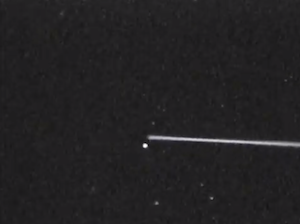
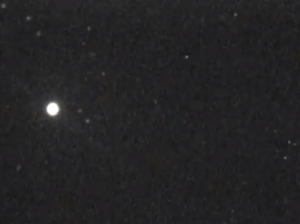
Two frames from a YouTube video shot January 4 2014 by Peter Maxwell Slattery, using a night vision monocular. The first frame shows Slattery aiming a laser at a dot moving steadily across the sky from right to left. The next frame is from a few seconds later and shows the “power up” effect. A YouTube search for “UFO laser pointer” brings up numerous videos with titles such as “UFO’s respond to laser pointers” and “UFO inspects my laser pointer”.
From NT News and the Herald Sun, via Open Minds. See also these other UFO-related laser pointer stories at LaserPointerSafety.com.
US: UPDATED - Arizona bill to make aiming a laser at aircraft a felony
The Tucson Police Department had about 50 lasing incidents in 2013; the perpetrator was caught in most of the cases. But there was little prosecution.
Orr says the bill is needed because “there’s really no punishment. The county prosecutor, because it's not at a felony status, doesn't go after them. And so literally, you get a ticket and nothing happens. But you're endangering lives."
Orr is working with Tucson police pilot Chris Potter, who says he has been hit by a laser pointer about 100 times in his career. Potter says a laser pointer permanently damaged his right eye around 2011.
According to News 4 Tucson, “the FBI will launch a public awareness campaign about the issue next month.” It was not clear if this was an Arizona-area initiative or nationwide.
From News 4 Tucson
UPDATED - February 4 2014: The Arizona House Judiciary Committee voted in favor of increasing the penalty for persons who point lasers at aircraft. HB 2164 would make it a Class 5 felony, with a presumptive sentence of 18 months in prison, to knowingly or intentionally point a laser at an occupied aircraft. And the penalty would go to 30 months if the act disables the pilot or causes serious physical injury to anyone on board. The legislator who introduced the bill, Ethan Orr, is considering reducing the penalty slightly, to a Class 6 felony, when it goes to the full House. Prosecutors could reduce the charge from a felony to a misdemeanor when appropriate. Orr said this might be the case for youths so that a single mistake would not result in a felony record. From KWST.com. A related article at AZCentral.com includes comments from LaserPointerSafety.com’s Patrick Murphy on the issue.
UPDATE 2 - May 1 2014: The bill was eventually amended to make the act of aiming at an aircraft a Class 1 misdemeanor. The act became an assault if the pilot was unable to safely operate the aircraft or if anyone onboard suffered a serious physical injury. The amended version passed both legislative bodies and was sent to Governor Jan Brewer, who signed it on April 30 2014. From the Arizona State Legislature legislative history of HB2164.
UPDATE 3 - September 23 2014: The Arizona Police Association and other law enforcement groups want to increase the penalty to a felony. They hope to introduce a measure when the legislature re-convenes in January 2015.
Canada: Regina has 12 laser pointer incidents thus far in 2013
This compares with five laser incidents during 2012, and one during 2011.
The officials reminded the public that lasing an aircraft is illegal.
From CTV News and OHS Canada
US: Tucson police pilot says he has permanent retinal damage from laser exposure
The statement came as hundreds of Arizona law enforcement pilots attended a safety seminar in Tucson focusing on laser beam incidents. In 2012 in Tucson alone, the police department’s air unit had “close to 50 incidents”, according to Potter. As of November 2013, Phoenix was the top U.S. city for laser incidents.
From KVOA News
US: FBI uses sophisticated surveillance to catch Portland man who lased ~25 aircraft
The operation was initiated in August 2013, after multiple incidents of lasers being aimed at aircraft around Portland International Airport. Four law enforcement aircraft were equipped with video surveillance cameras.
On August 10, five aircraft were targeted by a ground-based green laser. One was an Alaska Airlines flight; two were from the FBI and two were from the Portland Police Bureau. At the same time, a surveillance team was on the ground. Using information from the FBI/PBB aircraft sightings, the ground officers observed suspicious behavior from a male in the back yard of a duplex apartment. He was looking up at the sky. He removed something mounted from a stand or pole, and went inside. The laser strikes ceased afterwards.
Six days later, after reviewing the video, consulting Google Earth and Google Maps, and visiting the apartment complex, an FBI Special Agent determined that Apartment 35 -- the one previously surveilled -- was the most likely source of the laser. The apartment was occupied by 39-year-old Stephen Francis Bukucs.
Surveillance cameras were then secretly installed, watching Apartment 35. They could see in daylight, low light and nighttime (using infrared).
Click to read more...
US: Latest FAA statistics show 3,188 incidents, Jan 1 to Oct 17 2013
The 2013 figure of 3,188 laser/aircraft incidents is 16.7% higher than the same period in 2012. If incidents continue at the same pace, there will be 4,063 incidents in calendar year 2013.
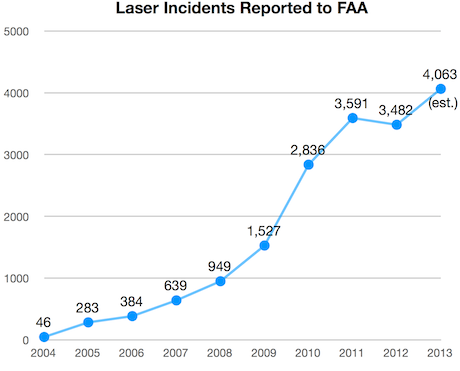
Total Incidents, 2004 to Date
There have been approximately 16,936 laser/aircraft incidents reported to FAA, from January 1 2004 through October 17 2013.For additional details on previous years, see the year-end statistics for 2012, 2011 and 2010.
Commentary from LaserPointerSafety.com
This 16.7% increase represents a setback from the 2012 totals, which were 3% lower than in 2011. Having a rise in 2013 incidents seems to indicate that the publicity and prosecutions which form the majority of current U.S. anti-laser efforts are not having the desired effect.
There has been some speculation that the 2013 figures differ from 2012 in part because FAA may have updated its incident reporting procedures. While FAA is working to include military and overseas incidents, this has not yet been done. In this respect the 2013 figures are directly comparable to earlier years.
Another possible explanation is that pilots have become more aware of the issue and are thus more likely to report a laser sighting. However, pilot information has been widely available since 2008 and has increased as this became of more concern. By now, most pilots should be alerted to the issue and FAA’s reporting requirements. There has not been a major push during 2013 in this area, so increased pilot reporting is probably not a major factor in causing 2013 reports to increase over 2012.
UK: Pilots want stronger laws, jail, for laser attacks
The Association says the lasers are too easily available, and that although it is illegal to aim a laser at an aircraft, the punishments have been too lenient: “Slaps on wrists and £150 fines are not enough.”
According to a September 29 2013 article in the Sunday Express, there were 1,570 laser incidents reported to the Civil Aviation Authority in 2012, and 1,911 in 2011. The most prominent airports cited were Birmingham, Manchester, Liverpool, the East Midlands, Bristol, Heathrow and Gatwick.
From the Sunday Express
US: FAA prosecutes 1.5% of all laser/aircraft incidents
This appears to describe civil cases brought by FAA based on violations of 14 CFR 91.11, which states “No person may assault, threaten, intimidate, or interfere with a crewmember in the performance of the crewmember's duties aboard an aircraft being operated.” The maximum penalty is an $11,000 fine. FAA announced on June 1 2011 its intent to charge laser perpetrators under this law, so the 129 cases referenced above would be since that time.
During the same time period, from June 2011 to September 2013, there were 8,507 reported laser/aircraft incidents in the U.S. This means that 1 out of every 70 reported incidents results in a civil prosecution. Stated another way, 1.5% of all laser/aircraft incidents result in a civil prosecution.
Click to read more...
Germany: 261 laser/aircraft incidents in 2012
This information was given by a spokesperson for Berlin Tegel airport, speaking after a September 8 2013 incident where a 14-year-old boy aimed a laser at three airplanes landing at the airport.
From BZ-Berlin (original German text and Google-translated English text)
Canada: Laser strikes up significantly in Edmonton
A police pilot spokesperson said laser users are not reading the packaging which clearly states not to aim at aircraft. After being caught, "There's been a lot of apologies, a lot of regret, some people not realizing the consequences of what they were doing, and then there's been the far opposite -- I can't believe this is happening, this is ludicrous, this isn't serious, it's just a laser pointer."
The pilot also said that a ban is not the answer: "If it's used properly, it's harmless. It's hard to ban something like that, the sale of it completely if 95% of the general public are using it properly."
He noted that not just police aircraft are being lased. Commercial and private aircraft also are at risk.
Edmonton police helicopter pilots are equipped with safety glasses for use during laser illuminations. They have two pair, one to attenuate red laser light and one to attenuate green laser light.
For details on the two most recent Edmonton incidents, on September 6 and 7 2012, see this LaserPointerSafety.com story.
From the Edmonton Journal and Edmonton Sun. Thanks to Keith Murland for bringing this to our attention.
Egypt: First-person account detailing laser use during Cairo protests
A new, first-person account from Egypt states that laser pointers were originally used to harass snipers and lookouts using binoculars, and to irritate political enemies. However, the dramatic use of dozens of lasers aimed at Egyptian army helicopters was intended as friendly, being used to “greet” the military who by this time was on the side of the protesters.
(It needs to be noted that, regardless of intent, laser light can flashblind and disrupt pilots. Due to the potential flight and crash hazards, it is illegal in the U.S. and many countries to even aim a laser towards an aircraft.)
Click to read more...
UK: More than 220 laser attacks in two years in West Midlands, says CAA
This is roughly one-third of the 700 incidents over the same time frame that involved aircraft in or above the West Midlands. (The 480 non-laser incidents included bird strikes, emergency landings, a bomb threat, a dog on the runways and closure of an airfield because of a flying kite.)
On one occasion in July 2011, four different lasers were aimed at a police helicopter in a single incident.
The British Airline Pilots’ Association asked for prison sentences for persons caught aiming at aircraft, as well as regulations over the sale of high-powered lasers.”
According to West Midlands police, laser attacks on their helicopter have fallen in months prior to July 2013.
From the Birmingham Mail. See also a related LaserPointerSafety.com article on BALPA’s laser pointer suggestions.
Egypt: Dramatic photo of lasers on helicopter was Photoshopped

The bright rays and the lens flare effects were not captured by the camera but were added later. This may have been done for artistic effect, or to make the lasers look more dangerous. However, this incident does serve as a reminder that “you can’t always believe what you see”.
Egypt: UPDATED - Dozens of laser pointers used in protests to simultaneously paint helicopters
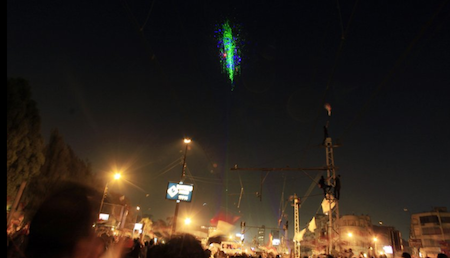
An aerial view, as seen on Egyptian network Capital Broadcasting Center, gives an idea of what the lasers looked like approaching Tahrir Square. In this scene, there is one blue beam and roughly 30 green beams.
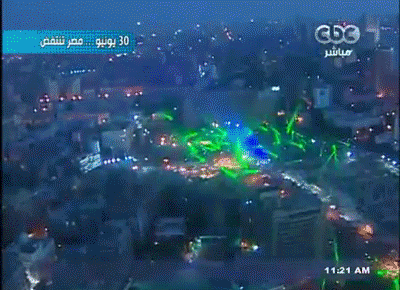
Animated GIF via “Cyparagon”. The original video can be viewed here (the aerial laser segment starts about halfway into this video).
There have been no reports of injuries to the air crews, or of the laser light causing the pilots to lose control. [UPDATE, July 8 2013: A first-person account states that the pointers were friendly, intended to “greet” the army pilots who at this point were on the side of the protesters.]
UK: Pilots want jail for persons aiming laser pens at aircraft
BALPA general secretary Jim McAuslan asked for a government cross-agency summit to address the problem. BALPA requested stronger regulations restricting the sale of high-powered lasers, more prosecutions, and action taken through trading standards.
He said that hotspots include airports at Manchester, Glasgow, Liverpool and Heathrow.
From ITV London and ITV Granada
US: Laser/aircraft incidents have increased compared to 2012
In 2012 and previous years, FAA was able to release detailed weekly reports tracking the number, type, and other data about laser incidents. But due to budget considerations in 2013, FAA has not yet been able to disseminate any reports. Thus, there is some uncertainty in the 1,500 approximation.
Based on this uncertainty, LaserPointerSafety.com has calculated that there could be between 1% and 16% more laser incidents in 2013 than in 2012. If accurate, any increase would represent a setback from the 2012 totals, which were 3% lower than in 2011. Having a rise in incidents would indicate that the publicity and prosecutions which form the majority of current U.S. anti-laser efforts are not having the desired effect.
The 2013 estimate of 3,774 incidents is based on comparing FAA reports from Jan. 1 to June 12 2013 to the same time period in 2012, and then extrapolating the 8.4% increase over the entire year. However, FAA changed their reporting procedures in 2013 so it is unclear how much of the estimated increase, if any, is an actual increase and how much is due to the new reporting procedures.
For the last comprehensive FAA figures, see our page Latest 2012 laser/aircraft incident statistics.
UPDATE, August 16 2013: New information shows 2,200 incidents from January 1 through August 2 2013. This is an 18% increase over the same period in 2012. Also, it does appear that FAA’s 2013 incident reports are comparable to 2012’s -- they have not yet significantly changed their reporting procedures or criteria. More information is at this LaserPointerSafety.com story.
New Zealand: UPDATED - Gov't to restrict handheld laser pointers
The new law will not cover low-power lasers below 1 milliwatt which are used for presentations, surveying or gun sights. It will control importation, and will restrict use of higher-power handhelds to “authorized users who have a legitimate purpose such as astronomers, researchers and the NZ Defence Force”, according to an Associate Health Minister.
Click to read more...
US: FAA study compares fixed-wing airplane laser incidents with helicopter incidents
The study found that helicopters were 3.4 times as likely to be illuminated at altitudes below 2,000 feet than fixed-wing aircraft. Helicopter aircrews were twice as likely to report adverse effects such as distraction, vision interference, operational problems, and pain.
The study also broke down adverse effects by the type of flight, such as commercial, law enforcement, medical and military.
One conclusion of the study is that the “results may also justify the expense of equipping rotary-wing aircraft (particularly law enforcement aircraft) with laser detection and tracking devices to improve the possibility of apprehending perpetrators of these offenses.”
A detailed summary is at LaserPointerSafety.com’s 2013 FAA helicopter study webpage. The full 6-page report is available online from the FAA.
US: L.A. Sheriff's Dept. puts "Laser Strike" info video on YouTube
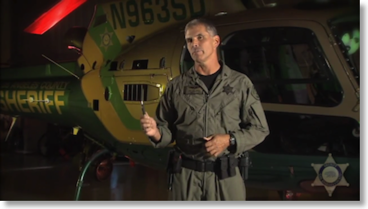
To see the video, click this link to YouTube. Following this link should also lead to the bonus content videos.
To get a flavor of the training video, click the “Read More…” link below for a list of selected excerpts and interesting statements.
Scotland: Pilots want stepped-up prosecution against laser attacks
An April 2013 investigation by the Scottish Express found 338 incidents in Scotland from January 1 2011 through February 13 2013. Only 12, or 3.5 percent, had been solved. The paper noted that the International Air Transport Authority (IATA) suggests there are 12 incidents involving lasers each day globally. [Note: The U.S. rate is approximately 9-10 per day, indicating the rest of the world’s rate is 2-3 per day which LaserPointerSafety.com believes to be higher.] An IATA spokesperson said the organization “support[s] strong penalties for anyone caught engaging in the act.”
The U.K.’s Civil Aviation Authority said there were 152 laser incidents at Heathrow Airport in 2012, compared with 136 incidents at Glascow Airport which has 1/10 the number of passengers.
The Scottish Express story contains additional statistics on Scotland airport lasing rates.
From the Scottish Express
US: FAA updates laser reporting method in AC 70-2A
The changes include:
- Air Traffic Control can now regard a laser illumination of aircraft incident as an “in-flight emergency”, due to the potential debilitating injuries which could compromise safety and interfere with aircrew duties.
- New web-based methods by which pilots can report incidents
- Additional information in the Resources and the Related Documents sections
The key part of the document is the reporting procedure: “On arrival at destination, all aircrews that have been affected by an unauthorized laser illumination are requested to complete the Laser Beam Exposure Questionnaire. The questionnaire is located on the FAA’s Laser Safety Initiative Web site at http://www.faa.gov/about/initiatives/lasers/ and can be electronically submitted. The questionnaire may also be printed and faxed to the WOCC at (202) 267-5289, ATTN: DEN, or emailed to laserreports@faa.gov.”
From FAA Advisory Circular 70-2A
US: 2012 laser/aircraft incident statistics
What is an FAA-reported “laser incident”?: This is defined as an aircraft pilot seeing one or more laser beams during flight. A mid-2011 study by Rockwell Laser Industries of 6,903 incidents reported to the U.S. Federal Aviation Administration found that in 27% of incidents, beams entered the cockpit (passed through the windscreen). For example, in 2011, there were 3,591 incidents of which approximately 970 (27%) involved beams in the cockpit.
Year-to-Date Comparison
The 3,482 reported U.S. laser/aircraft incidents in 2012 compare with 3,591 incidents during 2011, approximately 2,836 incidents during 2010, and approximately 1,527 incidents during 2009.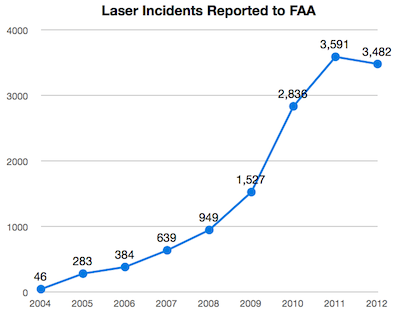
The number of U.S. laser incidents decreased slightly in 2012
Projected 2013 Estimate
If the number of laser/aircraft incidents in 2013 continues to decrease at the same rate as from 2011 to 2012 (-3.04%), then there would be 3,376 incidents in 2013.
Adverse Effects
In 36 (1.0%) of the 3,482 laser/aircraft incidents in 2012, a pilot or aircraft occupant reported a temporary adverse visual effect such as flashblindness, afterimage, blurry vision, eye irritation and/or headache. In four of the 36 eye incidents, the eye effect may have been more serious or long-lasting. In no incidents, either in 2012 or in previous years, was there any permanent eye damage.Total Incidents, 2004 to Date
There have been approximately 13,737 laser/aircraft incidents reported to FAA, from January 1 2004 through December 31 2012..
Click to read more...
US: UPDATED - Maryland bill reintroduced to raise fines on pointer/aircraft misuse
Click to read more...
US: Myrtle Beach area proposed ban on laser pointer sales
The ordinance would make it illegal to sell lasers over 1 milliwatt, or to sell any green laser to persons under 18. Adults misusing lasers would be charged with assault and battery, with a fine of up to $500, up to 30 days in jail, and being held liable for any damage or personal injury. Minors misusing lasers would be prosecuted in Family Court, plus parents would be held responsible and could be fined or jailed.
In addition, a warning would be required with the sale of every laser pointer.
Under county procedure, it takes three “readings” at council meetings to pass an ordinance. Based on the council’s schedule, the earliest it could be passed would be in January 2013.
From CarolinaLive. This is part of continuing stories at LaserPointerSafety.com about ongoing problems at Myrtle Beach and North Myrtle Beach.
New Zealand: Pilots want laser pointers prohibited
The pilots expressed concern following the September 2012 conviction of a teenager who aimed a green pointer at three commercial aircraft and a police helicopter in January 2012.
The NZALPA president said “It has reached a stage where any member of the public can purchase a commercial grade laser and do what they please with it.”
From Radio New Zealand and Voxy
US: New York area officials ask for public's help
A pilot from the Air Line Pilots Association told of his experiences when hit by laser light, and said that “Laser illumination can cause temporary blindness and even permanently damage a pilot’s eyes, potentially leading to an aircraft accident…Individuals must understand the danger and their responsibility to report anyone who misuses lasers.”
The Port Authority of New York and New Jersey is sending officers to schools near airports, to explain the hazards of lasers to children, and to warn them against aiming at aircraft.
An FBI agent said that the bureau is worried about adults and deliberate attacks by terrorists. Fines can range up to $11,000, said an FAA representative. a Coast Guard pilot said that rules requiring helicopters to break off rescues if they are directly lasered, adds to the risk of those the Coast Guard is trying to rescue.
The various law enforcement officials said they were asking the public to call 911 or local authorities if they see misuse, because laser incidents are so frequent and it is rare to apprehend the perpetrators.
A radio station public service announcement has been produced and aired by radio station NJ 101.5. It warns listeners not to aim at aircraft.
From NBC New York and New Jersey 101.5
US: Newsday editorial calls for warnings, enforcements to reduce laser attacks
The paper, ranked 13th in the country with a circulation of 393,000 weekday subscribers, said “It’s a serious offense that should be firmly punished…. Heavy fines, and in some cases, jail time, would send a powerful message that it’s a life-threatening crime.”
The editorial was the result of incidents in the Long Island area in the past month. It was titled “Enforce anti-laser laws with laser-like force.”
From Newsday. Subscriber information from USA Today.
UK: Leeds Bradford Airport has 3 laser incidents per week
From the Yorkshire Evening Post
US: Myrtle Beach considering further laser regs; current ones aren't working
A meeting was held with local officials, including representatives from Myrtle Beach, the Coast Guard, the Chamber of Commerce and the Horry County Council, to discuss options. The director of airports said that existing ordinances are not enough. He wants “a way to look at regulating the size and power of lasers that are sold in our community and region.”
Rather than local cities passing ordinances, one approach is for county-wide regulations. The topic will continue to be discussed at future county council meetings.
From CarolinaLive. This is part of continuing stories at LaserPointerSafety.com about ongoing problems at Myrtle Beach and North Myrtle Beach.
US: 198 calls to police about lasers in 3 months; Coast Guard "cracking down" in Myrtle Beach
The local Coast Guard echoes the concerns. Twice in two weeks, search and rescue missions were ended prematurely because of lasers being aimed at helicopters. (See a report here.) Under Coast Guard regulations, after laser exposure the aircraft is grounded and the pilots are medically evaluated before being allowed to fly again.
The Coast Guard issued a letter asking the public to stop aiming at aircraft, and saying that they want to enforce South Carolina’s state law against lading aircraft. The letter is reprinted below (click the “Read More” link).
From WMBF News. This is part of continuing stories at LaserPointerSafety.com about ongoing problems at Myrtle Beach.
Click to read more...
South Africa: 170 laser incidents so far in 2012; up about 66%
The information came at an August 1 2012 press conference where representatives from SACAA, airline pilots, a laser expert, and others spoke about the potential hazards of lasers being aimed at aircraft. SACAA was planning a public information campaign to warn about laser-aircraft hazards.
Penalties include a fine or up to 10 years in prison. But only three people have been caught. One was a minor and charges were dropped. The other two cases had “dragged on in the courts and the SACAA had lost track of them.”
From The Citizen. Additional statistics and information are in a story from Defense Web.
US: Appeal of 3-year sentence hinges on "willfully" aiming vs. "willfully interfering"
The August 2012 case in the U.S. Court of Appeals for the First Circuit hinges on instructions given to the jury during Gerard Sasso’s trial in January 2010. The judge in that trial told the jury that Sasso could be convicted for willfully aiming the laser at the helicopter. The judge also said that the government did not have to prove that Sasso knew that his aiming would interfere with the pilot.
Click to read more...
Australia: 733 laser incidents in 2011; appears to be almost 3x the U.S. lasing rate
The story did not give additional details. It is assumed this data is for all of Australia, since DIT is a federal agency.
From The Age
Commentary from LaserPointerSafety.com: Australia’s laser/aircraft incident rate appears to be 2.8 times the U.S. rate, based on incidents per capita. This is despite the fact that Australia has nationwide import restrictions on laser pointers, and that many Australian states severely restrict or ban possession of laser pointers.
There may be other reasons for this discrepancy. Perhaps laser incidents are not counted the same way in these two countries. Perhaps population is not the best way to compare the two countries’ laser incident rates.
However, on first analysis it appears that Australia has a significant problem with lasers being aimed at aircraft even though widespread restrictions on availability and possession of laser pointers. This is a preliminary indication that bans and restrictions may not work as anticipated. They may need to be combined with other actions, or it may be that other actions have more of an effect to reduce the incident rate.
Calculation details: Australia’s population is estimated at 22,680,322 as of July 25 2012. Australia had 733 incidents in 2011 according to The Age story above. This is a rate of 1 incident for every 30,942 persons. The U.S. population is estimated at 313,979,000 as of the same date. The U.S. had 3,591 laser incidents in 2011. This is a rate of 1 incident for every 87,435 persons.
.
US: "Epidemic" of laser misuse in Myrtle Beach
Laser pointers are available for as little as $4 at many beachfront stores catering to tourists.
The president of a Myrtle Beach helicopter tour company says that his aircraft are hit “two, three times a week, sometimes more.” He says the increase makes him nervous for his pilots and clients. He says there is no education for laser pointer buyers about the potential hazard.
Click for video interview with Huffman Helicopter president Jeremy Bass.
From CarolinaLive. This is part of continuing stories at LaserPointerSafety.com about ongoing problems at Myrtle Beach.
Canada: RCMP purchases anti-laser glasses
From Vertical magazine
Click to read more...
US: Lasers used to tag UFOs?
Rose refers to YouTube clips where handheld lasers are pointed at moving dots of light in the sky.
Click to read more...
Italy: 10 incidents at Aviano NATO airbase in 18 months
From StrategyPage.com and Air Force Times
Canada: Laser statistics for 2010, 2011 and Q1 2012
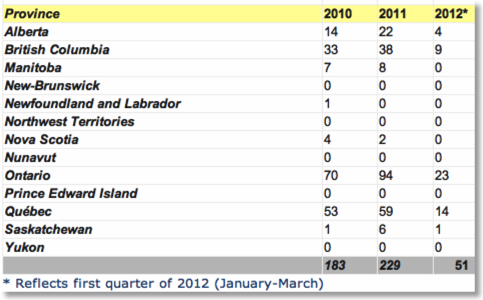
According to the Toronto Star, from January 1 to late May 2012 there have been 36 laser incidents at Pearson International and other Toronto-area airports, and 100 incidents nationwide. (This is probably based on their own analysis of the CADORS incident database since the Transport Canada chart above only went through the first quarter of 2012.)
WestJet has arranged for a Calgary-based ophthalmologist to examine pilots’ eyes after laser incidents. A spokesperson said “We want to have an individual identified in every major city so we can send that (pilot) right away to be tested.”
Canada lags other countries in aggressively prosecuting offenders, according to the chair of the flight safety division of the Air Canada Pilots Association: “The judicial system should apply the law to its maximum extent rather than soft-shoeing around the issue.” At the federal level, aiming a “directed bright light” at an aircraft is illegal under the Aeronautics Act. The maximum penalties are a prison term of five years and a fine of $100,000.
From the Toronto Star; chart courtesy Transport Canada
UPDATE, May 30 2012: At LaserPointerSafety.com’s request, Transport Canada analyzed first quarter incident statistics for the past three years. They found 29 incidents in Q1 2010, 27 incidents in Q1 2011, and 53 incidents in Q1 2012. (Note that they found two additional Q1 2012 incidents which were not included in the province-by-province breakdown above.) A Transport Canada spokesperson speculated that reasons for increased incidents in general may include increased awareness and reporting by pilots, and “copycat” actions by persons who would not think to aim a laser at aircraft until they hear news reports of incidents.
Scotland: 107 laser incidents in Glasgow in 2011
From the Scotsman
US: FAA to take harsher actions against persons aiming at aircraft
FAA has directed its staff not to seek warning notices or counseling, but to use “moderately high civil penalties” for inadvertent laser illuminations, and maximum penalties for deliberate violations.
In a video provided by FAA, LaHood said “I wonder how stupid people really can be” for not knowing that laser light could “cause great harm if the pilot is not able to continue to fly the plane safely…. people’s lives could be in jeopardy.” LaHood also said people should “understand that there are serious consequences to shining a laser at a pilot.”
The complete press release is below (click the “Read More...” link). This also has links to video and audio from LaHood and the acting FAA Administrator.
Click to read more...
UK: 15 laser incidents at East Midlands Airport in 10 months
Police warned of the hazards of endangering pilots and drivers, and noted that a violation could result in being sentenced to prison for life.
From This Is Derbyshire and the Loughborough Echo
UK: CAA issues Safety Notice to pilots, after 2,300 laser attacks in 2011
Below are highlights from the document, which gives some background information and statistics, and then describes how affected crew should prepare for and react to a laser attack. (Emphasis in bold added by LaserPointerSafety.com.)
Click to read more...
UK: Eye test for pilots available from CAA website
The ALESA card is available in hard copy, and can also be downloaded from CAA’s website. If downloaded, the Amsler Grid on the first page should be printed so it is 10 x 10 cm.


Click for PDF version from CAA ALESA webpage
When staring at the dot in the center of the grid, if the lines appear distorted or there are blank or faded areas, there may be a problem. The person is encouraged to remove themselves from aviation-related duties such as flying or air traffic control, and to see an eye specialist.
The second page has a flowchart of exposure conditions leading either to a “1” meaning unlikely eye damage or a “2” meaning eye damage possibility. If the person scores a “2”, the flowchart suggests they see an eye specialist.
From PilotWeb and the CAA ALESA webpage. The CAA press release about ALESA is here.
South Africa: 181 laser incidents in 2+ years
On March 25 2012, an ATNS statement noted that air traffic control towers have been illuminated by laser light, in addition to airplanes and helicopters. ATNS said there have been at least two arrests, but thus far, no prosecutions.
South African aviation groups are joining together to publicize the hazards and penalties of aiming lasers at aircraft. They are also considering strengthening laws. According to the statement, laser ownership requires a permit, but illegal sales are taking place via imports and black market stores.
From The Star via Independent Online, News 24, and the Daily News. Thanks to Dr. Ian Powell for bringing this to our attention. The ATNS press release is after the link (click “Read More…”).
Click to read more...
US & UK: UPDATED - Laser incident rate in U.K. more than twice the U.S. rate
- U.S. airports had 9,079,000 flights in 2011, with 3,591 laser incidents reported to the Federal Aviation Administration. This is a rate of one U.S. laser incident for every 2,528 flights. Said another way, this is 0.40 incidents per 1,000 flights.
- U.K. airports had 2,152,787 flights in 2011, with 1,909 laser incidents reported to the Civil Aviation Authority. This is a rate of one U.K. laser incident for every 1,128 flights. Said another way, this is 0.89 incidents per 1,000 flights.
The ratio of U.K. to U.S. rates is 2.24, meaning that the U.K. had more than twice the number of laser incidents than the U.S., when adjusted for the number of flights. (Important note: These figures do NOT mean that commercial aircraft are targeted at the rates indicated. Many laser incidents involve police helicopters. The analysis is simply meant to compare the two countries’ rates of laser misuse against aircraft of all types.)
It should also be noted that there could be many underlying factors affecting the precise numbers. For example, it is not known if the U.S. counts laser incidents in the same way as the U.K.
However, the figures do indicate that the U.K. rate of laser incidents appears to be significantly higher -- roughly twice the U.S. rate, based on the number of flights.
From an analysis by LaserPointerSafety.com, March 22 2012.
Updated May 27 2012 to correct a math error and make clear that it is the United Kingdom which has a higher rate of laser incidents (e.g., more incidents per 1000 flights). Our thanks to Brian Turner for pointing out this error.
Methodology: We define a “flight” as a takeoff plus a landing. US flight figures are from the Airline Activity “departures” statistic from the Department of Transportation’s Bureau of Transportation Statistics. It is assumed that each flight which departs also lands, so the data is accurate for “flights” as we have defined it. UK flight figures are from totaling column G, Total ATMs, from “Table 4, 1 Air Transport Movements 2011” found on the CAA UK Airport Statistics 2011 page. A UK “movement” is one takeoff plus one landing, so this is the same as our “flights” definition.
While the flight statistics compare only airline (US) and air transport (UK) flights, and do not include law enforcement flights, we believe this is a valid “apples to apples” comparison of how many more flights take place in the U.S. than in the U.K. A previous LaserPointerSafety.com analysis showed that law enforcement flights are less than 1% of the total flights from U.S. airports. Inclusion of law enforcement flight numbers would not significantly change the ratio of U.S.-to-U.K. flights.
.
UK: 1,909 laser incidents in 2011; renewed calls for laser ban or restriction
In 2011, a law was introduced by MP Greg Mulholland (Leeds North West), to make it a criminal offense to shine a laser into an aircraft cockpit.
According the Civil Aviation Authority, there were 1,909 laser incidents in the U.K. in 2011, compared with three in 2008. [Note from LaserPointerSafety.com: The 2008 statistic is almost certainly incorrect. A previous LaserPointerSafety.com news item from BBC News reported 27 lasers were used against commercial aircraft in 2007, and there were 80 cases from January through September 2008.]
From the Bradford Telegraph and Argus
UAE: Concern over lasers in Dubai and Abu Dhabi
DragonMart in Dubai claims to be “the largest trading centre for Chinese products outside mainland China,” with almost 4,000 shops. A Gulf News reporter found shops selling lasers under-the-counter for AED 40 to AED 80 ($11-$22). An internet search turned up lasers for sale in Dubai and Abu Dhabi around AED 500 ($136) that were described with terms such as “draw a line in the sky,” “extremely bright green,” and could cause “permanent eye damage”.
The article noted that United Arab Emirates officials have said that illegal use of lasers could lead to fines and jail time.
From GulfNews.com and DragonMart. We have found two articles about youths in Abu Dhabi being arrested after aiming lasers at a helicopter, in June 2010 and in October 2007. Video of the June 2010 incident, uploaded by the Abu Dhabi Police, is available on YouTube (click the photo to go to the YouTube page).
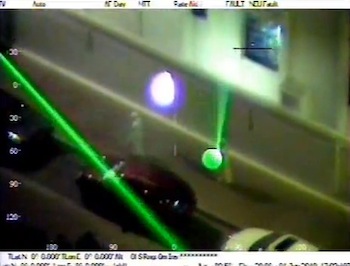
Two lasers, one from the left and one from the center, are briefly aimed at an Abu Dhabi Police helicopter, in a June 2010 video.
US: Obama signs bill making aiming laser pointers at aircraft a federal crime
Violation can result in a fine and/or imprisonment up to five years. The bill does provide a few exemptions for research and development, flight testing, the Department of Defense, and the Department of Homeland Security. The only exemption for ordinary citizens is when “using a laser emergency signaling device to send an emergency distress signal.”
The laser pointer misuse prohibition becomes part of the United States Code; specifically, Title 18, Chapter 2, new section 39A: “Aiming a laser pointer at an aircraft”. The text of the new law is here.
From AVStop News
US: 2011 total: 3,591 laser/aircraft incidents
Note: The FAA reports the 2011 total as 3,592. This is because the last entry in the FAA’s laser incident spreadsheet is on line 3,592. However, the spreadsheet headings are on line 1, so the actual number of 2011 incidents is 3,591 -- the number we use below.
What is an FAA-reported “laser incident”?: This is defined as an aircraft pilot seeing one or more laser beams during flight. A mid-2011 study by Rockwell Laser Industries of 6,903 incidents reported to the U.S. Federal Aviation Administration found that in 27% of incidents, beams entered the cockpit (passed through the windscreen). For example, in 2011, there were 3,591 incidents of which approximately 970 (27%) involved beams in the cockpit.
PowerPoint version available: A set of slides, presented to the SAE G10 aviation safety committee on Jan. 31, 2012, is available on the Files and Downloads page.
Yearly Comparison
Here are the number of incidents reported to FAA in recent years:- 2011: 3,591 incidents (9.8 per night)
- 2010: 2,836 incidents (7.7 per night)
- 2009: 1,527 incidents (4.2 per night)
- 2008: 949 incidents (2.6 per night)
- 2007: 639 incidents (1.8 per night)
- 2006: 384 incidents (1.1 per night)
- 2005: 283 incidents (0.78 per night)
- 2004: 46 incidents (0.13 per night) involving an unknown number of aircraft Note: FAA mandated that pilots report incidents using Advisory Circular 70-2, beginning January 19 2005. Before this date, pilot reporting was voluntary.
This is a total of approximately 10,201 incidents reported to FAA, from 2004 through the end of 2011.
Adverse Effects
In 55 of the 3,591 laser/aircraft incidents (1.5%), a pilot or aircraft occupant reported a temporary adverse visual effect such as flashblindness, afterimage, blurry vision, eye irritation and/or headache. None of these effects was classified as a recordable injury by FAA medical experts.In these 55 incidents…
- … there were 31 reports of pain or discomfort in the eyes or elsewhere (e.g., headache).
- … there were 31 reports of vision impairment such as afterimages (10) and blurry vision (7).
- … seven persons sought medical treatment after the laser exposure.
- … one person was grounded temporarily.
- … three flights were affected: in two cases, the pilot turned control over to the co-pilot; in one case the pilot felt he had to land immediately.
Rate of increase, by year
While laser incidents continue to increase, during 2011 the rate of increase slowed significantly.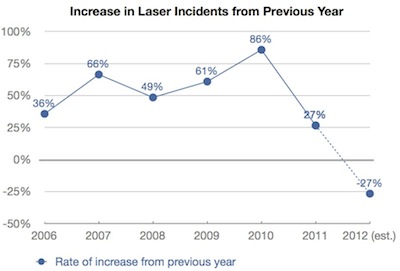
The rate of increase dropped 59% in 2011 (from 86.4% to 27%). If there is another 59% drop in 2012, (dashed line), then there would be a decrease in laser incidents for the first time, from 3,591 incidents in 2011 to 2,836 incidents projected for 2012.
Click to read more...
South Africa: 70 incidents in 2011, including a go-around; no arrests
The majority of South African incidents occurred in Cape Town, with other reports at OR Tambo, Wonderboom in Pretoria, and Lanseria International. In an incident in Lanseria, “two pilots were blinded so badly that after landing they couldn’t see the man who signaled where to park the plane” according to News24.com.
There were no persons arrested during 2011 for aiming a laser at aircraft. Over all years, there have only been two incidents resulting in arrests (as of January 11 2012):
- Around January 7-8 2012, three persons were arrested for pointing green laser beams at helicopters using the Bloemfontein civil and Air Force airports.
- During the 2010 World Cup, a man temporarily blinded a helicopter pilot in Durban
A Civil Aviation Authority spokesperson said “It is a serious hazard to point laser lights at aircraft.” The maximum penalty for an offense is a “hefty fine and up to 30 years in jail.”
The general manager of the Air Line Pilots Association of South Africa said ALPA-SA members were reporting increasing numbers of incidents where “sudden and intense bursts of light [are] deliberately shone at aircraft…”
From The New Age and DefenceWeb
Commentary from LaserPointerSafety.com: The figure of 70 incidents reported to ATNS in 2011 is probably low. A May 5 2011 news story quoted ALPA-SA as saying they receive between 10 and 12 complaints from pilots every week. That would result in 520 to 624 laser illuminations per year. Also, the 70-incident figure may be a misunderstanding or misquote. A news story from March 2011 quotes ALPA-SA as saying there were 70 incidents in the 10 months from April 1 2010 through February 28 2011; see News24.com.
.
US: Los Angeles TV news report about increasing laser pointer incidents
KABC quoted the Glendora regional police helicopter tactical flight officer who was illuminated as saying “The laser could cause [eye] damage, and there’s a potential for the helicopter to crash.” The report said he and a pilot were recently trained by the FBI in how to handle a laser attack and how to track down a suspect.
Laser incidents are rising both nationwide and at local airport Los Angeles International (LAX), stated the report. It concluded by reminding the public that “any offense jeopardizes the safety of everyone.”

Click the screenshot above to view the video report from KABC
From KABC
UK: MP wants action to reduce laser pen attacks at Leeds Bradford Airport
Figures for 2010 showed about 100 laser pen attacks on flights taking off or landing at the Yeadon-based airport. Figures from January 2011 through October 2011 showed 80 such attacks, indicating that the 2011 total would be similar to 2010.
A CAA spokesperson said laser pen misuse in Britain was not letting up in 2011: “The people who are carrying out these attacks are either still ignorant of the dangers high-powered lasers present to the safe operation of an aircraft, or they simply do not care.”
Mulholland said “a blanket ban on laser pointers is not the way forward because of the effect it would have on legitimate users. Something does, however, need to be done to address this serious ongoing issue.”
From the Bradford Telegraph and Argus
New Zealand: Concern over laser incidents
The tower manager, Fred Hanson, was quoted as saying he would like to make lasers illegal because “it just totally changes the light effect in the airplane.” The president of the New Zealand Air Line Pilots’ Association also called for restrictions such as licensing, and having to have a reason for possession: “They do have the potential to wreak a lot of damage.”
A spokeswoman for Air New Zealand said the airline was concerned, and they support prosecution. New Zealand law calls for up to 12 months in prison or a fine of up to $10,000 for interfering with an aircraft. In a current case, two Auckland men are being prosecuted for aiming a laser at a police helicopter.
From the Waikato Times
Note: LaserPointerSafety.com has run two stories to date about New Zealand laser incidents where the penalty was said to be up to 14 years. They can be found here.
Wales: Eight people convicted of laser offences thus far in 2011
A spokesperson noted that several of the arrests involved young people. He said, “We’re hoping parents will see this message so they can remind their children, if they have access to laser pens, not to use them irresponsibly.”
According to the news story, the maximum penalty for recklessly or negligently acting in a manner likely to endanger an aircraft is a fine up to £5,000, and/or five years imprisonment.
From NewsWales. One LaserPointerSafety.com news item about a 2011 Wales conviction is here.
US: ALPA holds major D.C. conference on the threat of laser illuminations
Speakers generally agreed on the nature and scope of lasers as a threat to air safety. They also offered similar solutions, including educating the public to not misuse lasers, prosecuting those who do, training pilots on how to "recognize and recover" from incidents, increasing the number of reports from pilots and the public, and restricting laser pointer availability.
The ALPA conference made news primarily for the announcement of a new FAA web page, which can be reached via www.faa.gov/go/laserinfo. FAA Administrator Randy Babbitt told the ALPA attendees that the web page -- erroneously described as a "website" in many media accounts -- would centralize the agency's information on laser/aviation safety. The page includes email addresses where pilots, air traffic control and the public can report laser incidents (see separate story about the FAA web page).
Babbitt also said that the FAA currently has filed 18 civil cases against individuals who aimed lasers at aircraft. There is a maximum $11,000 fine in each case.
Other speakers gave updates and information in their areas of expertise.Click to read more...
US: FAA urges pilots, public to report incidents on new webpage
- Reporting Laser Incidents: How to report an incident, for pilots, air traffic control officials, and the general public
- U.S. Laser Incidents by Year: A simple table listing incidents each year since 2005
- Laser Events and Civil Penalties: Press releases about the number of incidents in 2010 and about the June 2011 decision to impose civil fines of up to $11,000. Also, the legal interpretation justifying imposition of the fines.
- Hazards of Laser Illumination: Links to background information for pilots, and two studies of the issue by FAA’s Civil Aerospace Medical Institute
- Planning Light Shows and Other Outdoor Laser Operations: Information and forms for persons planning to use lasers outdoors
Below is the FAA press release announcing the web page:Click to read more...
Switzerland: Air rescue pilots to use laser protective eyewear
The action was taken because laser attacks are on the rise: six in 2009, 11 in 2010 and 16 to mid-October in 2011.
The sale of strong laser pointers was banned in Switzerland in May. The Federal Health Office is currently reviewing the possibility of banning their possession and use. Checks carried out by the Federal Office of Metrology this year showed that more than 95 per cent of the pointers tested were stronger than the permitted limit.
From SwissInfo.ch
UK: Heathrow laser incidents almost triple
From BBC News
Russia: Laser attack law passes first step in Parliament
The bill stipulates that hooligans whose actions have threatened transport safety will be fined 80,000 rubles ($2,580) or sentenced to up to three years in prison. People caught with pointing lasers at aircraft will get 7-year jail terms. Hooligans whose actions have led to the death of people or other grave consequences will get up 10 years in jail.
The bill also lowers the age of persons who could be punished for laser hooliganism from 16 to 14 years.
Only five cases of laser attacks were registered in the country in 2010, but in 2011 the number jumped to more than 30. One suspect was caught in Moscow this June, and another in the southern Russian republic of Chechnya a month later and received little or no punishment. A 17-year-old suspect was told he would "face very strict measures" if a similar incident occurs again, the Chechen Interior Ministry said on its website.
From RIA Novosti
Europe: 4,266 laser incidents; harmonized criminal laws sought
In 2008, there were 1,048 European incidents.
A Eurocontrol safety expert said “Preventing and mitigating the current problem requires a harmonized approach throughout Europe. We need the full involvement of regulators, judicial authorities, police, airlines and their associations, air navigation service providers, laser manufacturers who must understand how serious the problem is, as well as research institutes.”
Most European countries do not have specific laws against aiming lasers at aircraft. Eurocontrol stated they should be subject to the same restrictions as firearms, covering the purchase, transportation and use of lasers.
German politician Volker Kauder said that high-powered lasers should be treated as weapons under the Geman Arms Act.
From the Washington Post
US: Two FBI videos warning against lasers get 250,000+ YouTube views
The video highlights Justin Stouder, a St. Louis-area resident who was arrested in April 2010 for aiming at a police helicopter. He apologized at a news conference in July 2011 intended to publicize the illegality and hazards of lasers aimed at aircraft.
The FBI also released video excerpts of the Stouder laser incident and his subsequent identification by the helicopter and arrest. The incident/arrest video was about 10 times as popular on YouTube, with over 225,000 views:
The press release, and a transcript of the video, are below (click on the Read More… link).Click to read more...
US: Orlando Sentinel runs article on laser hazards
From the Orlando Sentinel
Russia: "Dragging its feet" on laser incidents
US: Laser beams usually are not tracking aircraft; most do not enter cockpit windows
The analysis was done by Rockwell Laser Industries (RLI). They examined 6,903 incidents in FAA’s database, dating from 2004 to mid-March 2011.The cockpit was illuminated only in about 1,875 incidents (27%). Of these, the exposure appeared intentional in about 350 incidents (19% of the cockpit illuminations; 5% of all illuminations). “Intentional” was defined as multiple beam exposures or the beam tracking the aircraft.
There were about 100 incidents (1.5% of all incidents) reported eye effects or injuries to the eyes. (A separate analysis by LaserPointerSafety.com shows that the vast majority of eye effect/injury reports are of minor, temporary effects. There are a few claims of eye injuries, and a very few confirmed claims of retinal injury.)
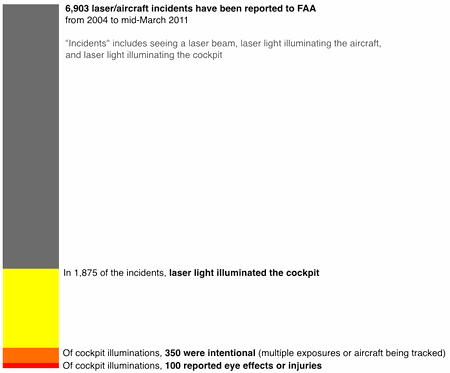
The RLI analysis was done by Kevin Donnelly, and was supervised and presented in August 2011 by RLI president Bill Ertle. Rockwell Laser Industries is a pioneer in providing services and products related to lasers and laser safety.
Uzbekistan: Meeting held to discuss laser "attacks"
Among those attending the meeting were representatives from the Ministry of Internal Affairs, committees of the city, flight crews and air traffic controllers.
[Note: News reports did not indicate whether laser incidents had yet taken place in Uzbekistan. A Google News search for anything to do with lasers in Uzbekistan turned up no results.]
From Trend and Central Asia Online
Russia: Chechnya bans laser pointer sales after one incident
UK: 270% rise in Surrey-area laser pen incidents
A spokesperson pledged to “deal robustly with any incident involving laser light whether it is an assault on another member of the public or a device being pointed at a vehicle. Laser pen owners should also be aware that Surrey Police’s collision investigation unit can pursue a manslaughter charge if it is found that a fatal or life changing injury collision is due to the use of a laser light. All offences have a power of arrest and could result in a term of imprisonment.”
Police are especially concerned about aircraft illuminations in East Surrey, near Gatwick Airport.
From Elmbridge Today, BBC News, and Redhill and Reigate Life. A list of laser pen offences, compiled by the Surrey police, is here.
Russia: UPDATED - Laser "blindings" increase
On June 8, a pilot was blinded by a laser pointer while landing a Boeing passenger plane in the southern city of Rostov-on-Don, but managed to land safely. The beam came from the area of a local market.
Earlier in the week a pilot of an Airbus A320 plane was blinded by a laser light during landing at the same airport
From RIA Novosti. In addition, Pravda carried a story with some additional details. See also other LaserPointerSafety.com stories about Russian aviation incidents and laser statistics.
UPDATED - June 24 2011: The German news agency DPA reported that these attacks, and additional ones in June in Rostov-on-Don, are the result of Islamist insurgents in the Caucasus region. See this story for details and sources.
UPDATE 2 - July 5 2011: A spokesman for the Federal Air Transport Agency said there have been more than 50 cases of “laser hooliganism” thus far this year in Russia, according to Bloomberg.
Canada: Pilots want lasing to be a criminal offense
Currently, violations of the Aeronautics Act can lead to fines of up to $100,000 and up to five years in prison. Despite this, laser illuminations continue to occur.
In 2010, there were 182 reported laser pointing incidents. Ontario had the highest number, 69, followed by Quebec with 53 incidents. Transport Canada and the ACPA said this was due to increased reporting, copycat laser use, and the increased availability of laser pens and pointers.
“This is just like shooting a gun at an airplane around [an] airport,” according to Nick Stoss, formerly with the Transportation Safety Board.
From Global Winnipeg
US: FAA to impose civil penalties of up to $11,000
The Wall Street Journal states that “[t]he change is intended to make it easier to punish violators without resorting to time-consuming criminal proceedings.”
Previously, FAA did not go after laser violators directly. FAA will now routinely bring civil charges, and these will be in addition to any other civil or criminal charges brought by others such as the FBI, or state and local law enforcement.Click to read more...
South Africa: Incidents are increasing; pilots express concern
A representative of the Civil Aviation Authority said that laser misuse violates two sections of the Civil Aviation Regulations, and can be punished with a fine and/or imprisonment of up to 10 years. (There was an arrest in 2010 during the World Cup, when 35-year-old Yusuf Ebrahim temporarily blinded a helicopter pilot.) The CAA representative said the Authority would consider new standards or regulations if they were recommended by the International Civil Aviation Organization.
To report a laser illumination incident in South Africa, CAA said to email information to cahrs@caa.co.za or fax it to 011 545 1453.
From Independent OnLine Scitech. An IOL story about Yusuf Ebrahim’s first court appearance is here.Click to read more...
South Africa: Up to 12 incidents per week, say pilots
ALPA-SA is calling for public education and a ban on handheld laser sales. According to the organization, there was a temporary drop in the number of incidents after media reports earlier in 2011, but the incidents are now on the rise again.
A spokesperson for the Civil Aviation Authority said “a few cases” had been reported thus far in 2011. He added that if the International Civil Aviation Organization introduced new regulations, the CAA would “definitely look into implementing it.”
From the Cape Argus
New Zealand: Pilots call for restrictions after 16 incidents to date in 2011
According to NZALPA’s vice president Glen Kenny, “There is no restriction on the sale and distribution of commercial-strength lasers in New Zealand. In Australia they treat Class 3 lasers or higher as a potential weapon."
NZALPA had previously proposed restrictions in New Zealand “two or three years ago” but the organization wanted it given a higher priority. A spokesman for the Ministry of Health’s National Radiation Laboratory said the issue was “still being considered.” He did note that there have been “successful police prosecutions where people had carelessly or deliberately aimed lasers at vehicles or aircraft.”
From the New Zealand Herald
Grenada: Increasing incidents
Violators could be charged with interfering with air crew duties. The Authority is looking for the laser perpetrator(s), and has posted notices in newspapers stating that shining lights at aircraft is “a security offense”. Also, several pilots have filed complaints with the Eastern Caribbean Civil Aviation Authority.
From the Virgin Islands News Online
Switzerland: Incidents double to 80 in 2010
From GenevaLunch.com
Italy: 479 incidents in 2010
From L’Eco di Bergamo (in Italian)
Germany: 273 (or 388) incidents in 2010; call for ban on pointers
He recommended fast action. He discussed a European import ban, as well as classifying lasers as a weapon, and prohibiting private possession of Class 3 and Class 4 lasers. He said, “I call on the competent authorities to submit to the problem of dangerous laser fast red tape as possible solutions, before something happens and people get hurt.”
The pilot’s union Vereinigung Cockpit said an import ban is not sufficient, because customs checks are difficult. Cockpit board member Joerg Handwerg said "Although lasers may not be sold in shops with a capacity of more than one milliwatt in Germany, but you get the devices in the Internet.” The group wants to prohibit the possession of equipment for private individuals.
Original articles (in German) from Rettung Magazine, Fluege.de News, and Heute.de.
*NOTE: An April 23 2011 article from N-TV.de says there were 388 “attacks with laser pointers at pilots” in 2010. This is according to the German air traffic control agency, DFS. The article had no additional information that might account for the discrepancy with the 273 incidents in 2010 that is quoted above.
Canada: Man gets lower fine, in part because pilot did not lose control
Provincial Judge Paul Sully said the August 19 2009 incident was "not as serious” as the prosecutor described, since the pilot did not lose control, but instead was "momentarily blinded from viewing his instruments [and] was able to complete his orbits.” In addition, the judge noted that the pilot was familiar with the dangers of laser light.
Judge Sully also rejected the prosecution’s notion that the man should have culpability: “The offender had a momentary loss of common sense which resulted from his failure to recognize the high standard of care needed when handling a laser.”Click to read more...
Australia: 2008 "cluster attack" caused by boys on bicycles
However, it turns out that this incident was caused by boys on bicycles, apparently acting without pre-planning and not knowing how the lasers would affect pilot vision. During a Feb. 2011 briefing to the SAE G10T laser safety group , FAA flight standards liaison Patrick Hempen said that the truth about Sydney has not caught up with the news stories: “The attacks are usually spontaneous in nature, perpetrated by careless or malicious persons.”
Hempen said that investigation by US and Australian officials revealed that the Sydney "cluster attack" was caused by youths, riding their bicycles on a golf course at night, who stopped and took the occasion to illuminate landing aircraft. He noted that the youths’ local community had a history of acrimony directed at the airport authority due to the construction of a new runway which caused more flights over their residential area.
Hempen also investigated several laser events in the Mideast and found many of the so-called "deliberate attacks" to be similar; they were “events perpetrated by youths, in a party-like atmosphere, without care or knowledge of the havoc that they were causing.”
Based on a Feb. 1, 2011 presentation to SAE G10T.
US: New York Times calls attention to pilots' laser risk
From the New York Times. Readers of the Times article may also be interested in clarifications, tips and links compiled by LaserPointerSafety.com.
US: 2,836 laser events reported in 2010; FAA expresses concern
FAA spokesperson Laura Brown told LaserPointerSafety.com that in roughly 90% of the reports, the cockpit and/or pilot was illuminated by the laser. (In the other 10%, a beam was seen outside the aircraft but light did not enter the cockpit.) As far as injury reports, Brown said that these were “fairly rare”.
The FAA’s press release listed the top 20 affected airports, with Los Angeles International Airport topping the chart with 102 “laser events” in 2010. LaserPointerSafety.com has further analyzed the airport data to show that for these top 20 airports, an event occurred once every 7,000 takeoffs and and landings; the analysis is here.
According to the press release, “[t]he increase in reports is likely due to a number of factors, including the availability of inexpensive laser devices on the Internet; higher power levels that enable lasers to hit aircraft at higher altitudes; increased pilot reporting of laser strikes; and the introduction of green lasers, which are more easily seen than red lasers.”
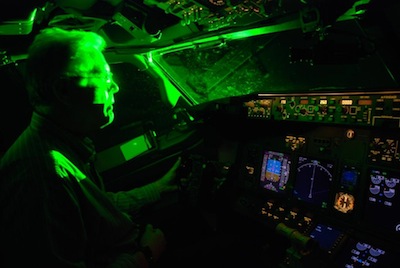
The FAA released the photo above, illustrating what a direct laser illumination of a cockpit can look like.
To read the full FAA press release, and see the list of 20 most affected airports, click the “Read More...” text below. In addition, updated statistics for the current year are here.
US: FAA issues study of 2,492 laser events from 2004 to 2008
The study is entitled “The Illumination of Aircraft at Altitude by Laser Beams: A 5-Year Study Period (2004-2008)”. The FAA’s abstract is here; and the full 12-page report in PDF format is here.
US: Ocean City NJ discusses a ban on laser pointers
The move came after a report one week earlier about seven incidents when aircraft landing at Atlantic City International Airport had been illuminated by lasers. Police noted that while pointing at an aircraft is a crime, owning or selling lasers is not against the law.
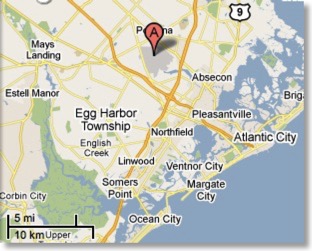
Ocean City, New Jersey, location in relation to Atlantic City International Airport (“A” on the map above)
From the Press of Atlantic City. An earlier story (August 18 2010) has additional details about the aircraft illuminations and the efforts to stop sales; see this Press of Atlantic City article. A January 23 2011 Press of Atlantic City article updates the laser situation in the Ocean City area.
Related LaserPointerSafety.com news stories about Ocean City and New Jersey laser troubles
- August 26 2010: Ocean City officials discuss city-wide ban on laser pointers after summer incidents.
- November 22 2010: State senate bill 2430 is introduced in November 2010 to ban laser pointers above 1 milliwatt.
- June 8 2011: Man buys laser in Ocean City, points it at helicopter, and is almost immediately arrested.
- June 11 2011: Residents report harassment; voluntary sales ban is not working.
- June 24 2011: Unanimous vote on the initial measure to ban Ocean City laser pointer sales and possession.
- July 14 2011: Unanimous vote on the “second reading” to make the Ocean City ban official.
- April 16 2013: North Wildwood NJ bans sale and possession of laser pointers above 1 mW.
- August 20 2013: New Jersey state legislature passes bill to ban laser pointer sales above 1 mW; sends bill to Governor for signature.
- October 17 2013: Governor Chris Christie vetoes bill to ban laser pointer sales, saying the 1 mW power limit was “arbitrary” and there was no criminal use of lasers between 1 mW and the federal limit of 5 mW in New Jersey.
Canada: 2010 laser/aircraft incidents almost double 2009
Transport Canada also released figures on incidents in Alberta, after an Aug. 16 arrest in Calgary. So far in 2010, there have been 11 reports of laser beams aimed at or hitting aircraft, compared with nine in all of 2009.
From the Calgary Herald
UK: Laser beam air attacks on rise
Some of the more interesting quotes:
- Pilot Kevin Medlock: "It's so brilliant, it takes away part of your vision for a few minutes at least. We fly an aircraft, 148 passengers, making an approach to landing at 170 miles per hour. The consequences of someone shining a laser in my eyes at that stage of flight isn't worth bearing the consequences." Medlock was hit by laser beams twice in one month.
- "What's worrying experts is the rate at which the problem is growing:" 29 U.K. attacks in 2007, 206 attacks in 2008, and 461 in 2009 (through September).
- (video of teen walking into court) "This man said he was trying to see how far his laser could reach. Dean Bottomley was sent to jail."
- Captain Bob Jones, U.K. Civil Aviation Authority: "We're trying to raise the awareness of the general public, rather than worry or frighten them."
From BBC News
Germany: Laser pointer attacks increase
According the country’s DFS air traffic authority, reports of laser pointer incidents in Berlin, Hamburg, Frankfurt, Stuttgart and Saarbrücken have spiked in recent weeks. One particular incident where a laser pointer caused a “disturbance” is under investigation by the German Federal Bureau of Aircraft Accidents Investigation (BFU), the organisation reported.
“In our assessment this is very dangerous,” DFS spokesperson Kristina Kelek said on Thursday.Click to read more...
Canada: List of many Canadian incidents
- A Cessna pilot flying over downtown Vancouver on May 25 2009, who had "flash blindness for a few seconds"
- More than two dozen reports of lasers being directed at airplanes in British Columbia since 2000.
- About 100 incidents of laser beams pointed at aircraft across Canada, since 2005.
- A Cessna pilot in June 2008 who "experienced slight vision impairment, and for safety reasons requested a wide left-hand 270-degree turn ... for brightness recovery and a stabilized approach".
- A helicopter co-pilot in November 2007 who looked at a laser and "was experiencing sun spots [sic] in her vision, which continued for the remainder of the flight."
- At least three incidents, two in June and one in November 2008, where Royal Canadian Mounted Police pilots were targeted.
- In July 2008, a Calgary man was fined $1000 after pleading guilty to shining a laser at an Air Canada flight.
Culbert's story also lists the first attack LaserPointerSafety.com is aware of on a blimp: "A green light was pointed into the cockpit of a blimp over Victoria's [B.C.] shoreline in October 2005. [CADORS reported that] 'several laser attempts were made and the pilot said he was affected twice. Quite aggressive attempts were made by the person using the laser light according to the pilot.' "
UK: Police "fight back" by tracking laser hits

1: Police helicopter is targeted by laser pointer on the ground. 2: Helicopter crew use Laser Event Recorder to locate pointer via GPS, and record its wavelength. 3: GPS details enable helicopter’s thermal (infrared) camera to find suspect, and send police patrol on the ground to arrest the person.
In addition, the UK’s Civil Aviation Authority is planning new laws prohibiting shining a laser at an aircraft. Currently, prosecutors have to prove that the laser user “recklessly or negligently endangered an aircraft”.”
BBC quotes Bob Jones, head of flight operations at the CAA: “"To those individuals targeting aircraft with laser devices the message is clear -- don't. You will be caught and you will be prosecuted and you could spend up to five years in prison. These things are not toys, they pose a serious risk to all flight safety."
Many more details, including photos and a video of a helicopter finding a laser perpetrator, are at the BBC News website.
US: 148 incidents in less than 2 months
On Friday, Feb. 20, 2009 alone there were reports of incidents in Salt Lake City and Ogden, Utah; Lake Charles, Louisiana; Orlando, Florida; and Burbank and San Jose, California. On Sunday, Feb. 22, 12 different jetliners landing in Seattle were illuminated by an unknown person with a laser pointer.
Information from a CNN story on the Feb. 22 Seattle attacks; see paragraphs 6 and 7. There is also a video version of this story at CNN’s website.
Ireland: Pilots call for pointer ban
The Irish Aviation Authority has said ten incidents have occurred since September 2008. Aer Lingus airlines said six of their flights were targeted “in recent months”
From RTE News. The article also has links to two RealAudio video reports on the pilots’ call for restrictions, and on the Dublin incidents.
Canada: Video report on "stupid hobby" of shining laser lights at planes
Also, there is a related print story from the CBC website. It does not have the same voiceover as the video report, but does go over similar points, including this one:
"We don't want this to become a bigger hobby — a bigger, stupid hobby," said Serge Beaulieu, spokesman for the Air Canada Pilots Association.
Canada: Pilots call for better labeling; tougher penalties
According to Transport Canada, there have already been 56 occurrences this year [2008] compared with 21 in 2007. The department has recorded a total of 83 since 2005.
"The increase in the number of laser events that are occurring in Canada and around the world are alarming to us," said Capt. Barry Wiszniowski of the Air Canada Pilots Association. "The laser events that are occurring are probably one of the greatest safety concerns that we have right now as a profession."
Wiszniowski said the industry is calling on laser manufacturers to develop labeling that will contain warnings similar to those on tobacco products.
He is also encouraging the courts to issue stiffer penalties to offenders.
Many more details at Metronews
Canada: Number of pilots blinded by laser pointers increases
As of October 17 this year, Transport Canada had received 46 reports of incidents involving "directed bright lights" being shone at a civilian airplane's cockpit from the ground, says Jean Riverin, a spokesman for the national regulator. This compares with 21 reports for all of 2007, and only three each for 2006 and 2005. When Transport Canada receives a complaint, adds Riverin, "we notify the RCMP or local police, who coordinates the investigation."
It is an offense under section 74.1 of the federal Aeronautics Act to "engage in any behaviour that endangers the safety or security of an aircraft in flight." A violation of the act can lead to a maximum penalty of $100,000 or five years imprisonment following a conviction, or to $25,000 or 18 months imprisonment following a summary conviction.
Click to read more...
UK: Growing concern over laser pointers
The pilot, who was over Stockport at the time, was temporarily blinded. Unable to read his instruments, he had to make dangerous emergency manoeuvres.
This case highlights a growing concern about the inappropriate use of more powerful green laser pens or pointers.
Britain's largest pilots union BALPA has recently warned of a major air disaster unless action is taken.
Click to read more...
Wired Magazine: Laser pointers a "huge safety risk" for aircraft
According to The Washington Post, the FAA reports during the first half of this year [2008], there have been more than 175 cases of lasers shot at aircraft, and more than 900 incidents since 2004. In most cases these were not powerful industrial lasers, but the commonplace pointers wielded by countless college professors and mid-level management types.
Additional details from the Wired Magazine blog post
